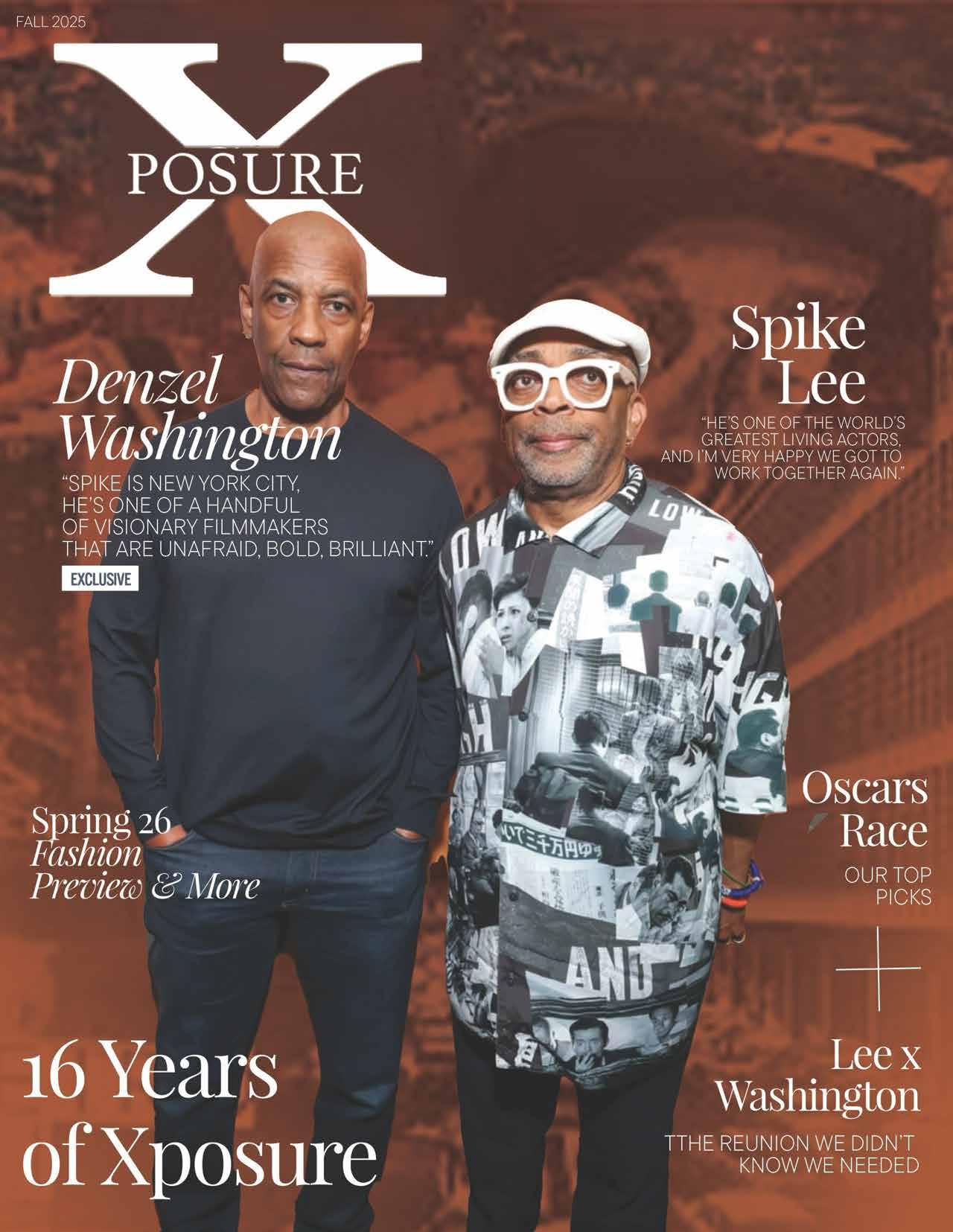

Emirates
Juicy
Cécred
One
A$AP
LVMH’s
Style
Edward
London
Labrum
Range




Emirates
Juicy
Cécred
One
A$AP
LVMH’s
Style
Edward
London
Labrum
Range

It’s an honor — and an incredible blessing — to write this letter celebrating 16 years of Xposure Magazine.
On September 10, 2009, I pressed “publish” and officially launched what I thought would be a small, local Atlanta magazine.
My honest hope was that a handful of people might read it. What happened next changed everything.
Within 24 hours, nearly 10,000 readers worldwide had discovered Xposure. Convinced there had been a glitch, I called tech support to verify the numbers. But no — the map was real. From that moment, I knew something special had begun.
It’s all God. If you’ve been here since day one, you know my faith is the foundation of it all. Every step, every milestone, every opportunity belongs to Him.
Since that first issue, Xposure has grown into an independently owned and operated global publication, now reaching readers in more than 75 countries and available in over 20 languages. To everyone who has supported, shared, and believed in this vision — thank you. You’ve stood by me through every high and low, and your love has kept this dream alive.
This anniversary issue is especially close to my heart. It’s been almost 19 years since Academy Award winners Mr. Spike Lee and Mr. Denzel Washington last worked together on Inside Man. Having them as our cover stars is a full-circle honor.
My first encounter with Mr. Lee, happened on Father’s Day 2024 during a Tribeca Talks event moderated by JR in conversation with Mr. De Niro. Mr. Lee walked to a microphone as the crowd cheered. He asked for advice on navigating the loss of his father as it was his first. The room filled with so much emotion, tears and love as we ran to Mr. Lee to console him. It was in that moment, emotionally overwhelmed I watched as people of all walks of life and backgrounds envelope Mr. Lee. He was surrounded by so many people he disappeared for a moment. As we attendees were leaving the venue, a lot of conversations on how much the event as a whole and that moment meant to us who were also missing our dads. Thankful to have had that collective experience especially on that day.
Mr. Lee, my has always been my all-time hometown hero, has been a creative force and personal inspiration (and yes, I still smile every time I pass his Grady Health billboards). Mr. Washington’s strength, grace, and consistency have been equally profound influences in my life.
In our cover story, “Highest 2 Lowest,” these two legends reflect on legacy, brotherhood, and the art of reinvention. We take you inside the Brooklyn premiere and afterparty, with a look behind the scenes at how the film came
together — plus exclusive access from our friends at A24, Apple Films, and 40 Acres & A Mule Filmworks.
September has always felt like a month of renewal — and that’s especially true for those of us who live and breathe Fashion Month. This season, I had the joy of attending London Fashion Week, where the energy, artistry, and authenticity on the runways were nothing short of inspiring. While in London, I was able to connect with one of my all time favorite fashion creatives Mr. Felix Prince. I had the pleasure of meeting Felix last September during LFW and loved his style, knowledge and passion for fashion. It’s my incredible honor and privilege to announce Felix as my new Fashion Editor! Felix, I’m honored to have you along this journey and I’m excited to have your first article as Fashion Editor in the following pages. The best is yet to come and it’s never been a more exciting time!
While in London, I had the privilege of reconnecting with Edward Enninful, as he celebrated the launch of 72 Magazine. What a moment — a true reminder of how visionaries continue to evolve, inspire, and redefine creativity.
We also highlight some of my favorite moments from Milan and Paris Fashion Weeks — from Mr. Armani’s timeless elegance to Demna’s bold debut at Gucci, to the breathtaking finale collections that reminded us why fashion is storytelling in motion.
And of course, Awards Season is officially underway. Our team has gathered early Oscars predictions, breaking down who’s in the running — and why Sinners”might just steal the spotlight as it has done the entire time.
Beyond the red carpets and runways, this issue also brings you stories that celebrate craftsmanship, travel, and legacy. We revisit the Nobu Beach Inn in Barbuda for an exclusive update, explore the recent sale of the iconic Flying Fox by Lürssen, and spotlight innovators shaping the next chapter in luxury design and hospitality.
Lastly, and most importantly, I dedicate this milestone issue to my parents and my brother, who I’ve lost along this journey. I know they are proud — they would have cheered, laughed, and cried happy tears at how far we’ve come. I carry them with me in everything I do, every single day.
To everyone who’s been part of this journey — from contributors to readers to partners — thank you. You’ve helped build a global community rooted in creativity, culture, and faith. Sixteen years later, Xposure is still here, still thriving, and still telling stories that matter.
As I always say, the best is yet to come.
With love and gratitude,
Goldyn P. Smith Founder and Editor-in-Chief
In a bold move to reset its business strategy, Kraft Heinz—once the powerhouse born from the 2015 merger of Kraft Foods and H.J. Heinz—is unraveling. On September 2, 2025, the company announced plans to spin off into two autonomous, publicly traded entities by the second half of 2026. The decision reflects mounting pressures to regain agility in an era of shifting consumer appetites, underwhelming financial performance, and investor impatience.
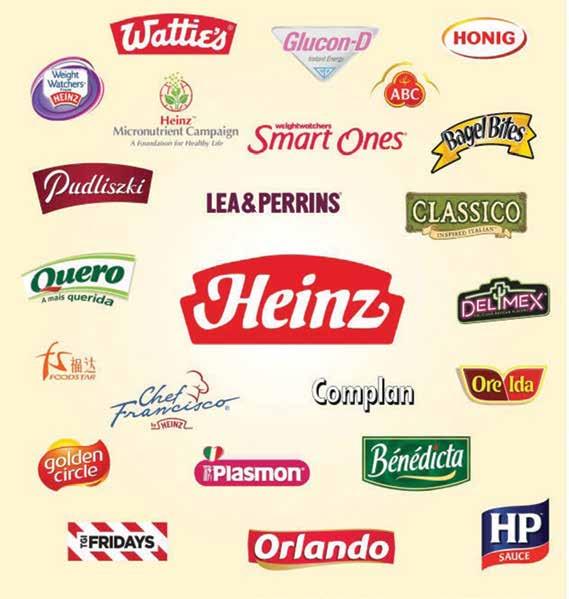

The company will be divided into:
Global Taste Elevation Co.
(~$15 billion in annual sales) housing globally iconic brands like Heinz, Philadelphia, and Kraft Mac & Cheese.
North American Grocery Co.
(~$10 billion in sales), focusing on familiar staples like Oscar Mayer, Kraft Singles, and Lunchables— led by current CEO Carlos Abrams-Rivera.
The board unanimously approved a tax‑free spin‑off, hoping the restructuring will sharpen focus on brand‑specific strategies, unlock shareholder value, and sustain existing dividend levels.
Immediate Market Response:
Kraft Heinz shares plunged ~7% upon announcement, reflecting investor unease.
Analyst Perspective:
While some worry the breakup may be costly (estimated $300 million in separation expenses), others—like Morgan Stanley’s Megan Alexander—see this as a structural improvement, comparing the split favorably to Kellogg’s successful model.
Buffett’s Disapproval:
Berkshire Hathaway, owning ~27% stake, voiced strong disappointment. Warren Buffett criticized the move as expensive and unlikely to solve deep-rooted challenges.
Value Dynamics:
Despite skepticism, some see opportunity: if both companies execute well—investing in innovation, fending off private label competition, and responding to healthier consumer trends— this separation could pay off in the long run.
For shoppers, the split is more about behind-the-scenes structuring—initially, pack designs and brand formulations may remain unchanged. However:
Sharper Brand Focus: Each company can now tailor product development and marketing toward either global taste trends or regional grocery habits. This could eventually mean improved innovation, packaging, or health-conscious options.
Speed and Responsiveness:
A less centralized structure means quicker adaptation to emerging consumer demands—like clean-label, reduced additives, or fresh format lines.
But outcomes hinge on execution. Without reinvigorated investment and clarity, the split may end up as a symbolic reshuffle rather than a meaningful consumer win.
Kraft Heinz is not alone. The move mirrors decisions at other consumer giants—like Keurig Dr Pepper and Kellogg—re-examining the once-celebrated “all-in-one” conglomerate model. Market dynamics now favor nimble portfolios over sprawling structure.
Kraft Heinz’s split marks a pivotal shift—a tactical retreat from one size fits all consolidation toward strategic clarity. For shareholders, the reorganization provides a chance to unlock latent value or fall flat, depending on leadership and investment. For consumers, the potential lies in rejuvenated, brand specific innovation and relevance—if both new companies act swiftly and wisely. As the food industry evolves, Kraft Heinz is betting that focus, not scale, will determine its future.

A federal appeals court delivered a decisive blow to former President Donald Trump’s sweeping tariff strategy, ruling that he exceeded his authority by imposing broad import taxes using emergency powers under the International Emergency Economic Powers Act (IEEPA) of 1977. In a 7–4 decision by the U.S. Court of Appeals for the Federal Circuit, judges reaffirmed that only Congress—not the president—has constitutional authority to levy tariffs. Despite the ruling, the tariffs—including those targeting China, Canada, Mexico, and others— will remain in effect until at least October 14 (or 15) to allow the Trump administration to seek a review by the U.S. Supreme Court.
The court concluded that the language of IEEPA permitting the president to “regulate … importation” does not implicitly authorize unilaterally imposing sweeping tariffs. Rather, any such authority must be explicitly delegated by
Congress—a threshold that IEEPA fails to meet. This ruling follows a May decision by the U.S. Court of International Trade, which similarly struck down Trump’s “Liberation Day” tariffs along with other emergency based import duties, finding that they exceeded constitutional authority. Together, these judgments underscore the judiciary’s insistence that tariff setting is a power reserved to Congress.
Economic Impact: Trump’s tariffs have generated substantial revenue—reportedly up to $28–31 billion in August alone, contributing meaningfully to monthly federal receipts. The loss of this stream could impact deficit reduction plans and influence bond markets, potentially raising long-term Treasury yields.
Executive Authority: The court’s decision marks a significant rebuke to assertions of sweeping executive power. While supporters argue such authority is necessary for rapid economic action, critics warn it erodes constitutional checks and undermines democratic oversight.
Supreme Court Appeal: The Trump administration has vowed to escalate the case to the Supreme Court, staking significant constitutional and economic implications on how far executive power can reach.
Congressional Fixes? Lawmakers are already responding. The proposed Trade Review Act of 2025 would require Congressional approval for new or increased tariffs—and mandate expiration within 60 days absent such approval.
Market Watch: Businesses, investors, and policy analysts are closely monitoring, recognizing that a shift in tariff policy could ripple across trade talks, supply chains, and economic strategy.
The August 29, 2025, federal appeals court decision marks a seminal moment in the ongoing debate over executive power and trade policy. By ruling that President Trump exceeded his authority
under the IEEPA when issuing sweeping tariffs, the court reaffirmed the constitutional boundary that only Congress may impose taxes and duties.
Nevertheless, the tariffs remain active—for now—pending Supreme Court review and potential legislative reforms. As the case moves forward, the outcome will likely reshape the contours of presidential authority and the future of U.S. trade policy.
In a dramatic response to sweeping U.S. tariff changes, major European postal services—from France’s La Poste to Germany’s Deutsche Post and Spain’s Correos—have abruptly suspended most parcel shipments to the United States. Set to begin August 29, 2025, the U.S. is ending its longstanding “de minimis” exemption, which allowed packages valued under $800 to enter duty-free. Now, these parcels will face a 15% tariff, catching many postal operators off guard.

Postal operators cite critical uncertainty and insufficient preparation time. DHL, Europe’s largest logistics company, stressed in a statement that key questions remain unresolved—such as who will pay the tariffs, how to collect them, what additional data is required, and how to transmit this information to U.S. Customs and Border Protection. Many providers say they’re “forced” to pause operations rather than risk non-compliance or chaos at customs.
Germany, Denmark, Sweden, and Italy halted shipments immediately over the weekend. France, Austria, and the UK are rolling out suspensions in the days that follow, varying by local timelines.
Swiss Post announced a temporary suspension starting Tuesday as well.
Shipments not clearly commercial, especially those marked as gifts under €100, may still be accepted—but will undergo extra scrutiny to ensure they don’t slip through as commercial goods.
Last year, 1.36 billion packages entered the U.S. under the privilege of the de minimis rule, representing $64.6 billion worth of goods. Analysts warn this change could severely disrupt small and medium-sized exporters, especially those relying on low-cost parcel-based e-commerce.
PostEurop, the body representing 51 European public postal operators, warned that unless clear guidelines or practical solutions emerge, the halt could extend beyond August 29. Royal Mail hopes the pause will be brief, potentially resuming by midweek, but for now, uncertainty reigns.

What began as a regulatory shake-up has quickly evolved into a transatlantic logistics crisis. With insufficient clarity and no time to adapt, European postal services are taking the cautious route—press pause. The outcome rests on how swiftly operational details are clarified—or the disruptions may become surprisingly long-term.
In a sweeping class-action settlement announced September 5, 2025, AI firm Anthropic agreed to pay at least $1.5 billion, plus interest, to authors whose copyrighted works were used without permission in training its AI systems. With payouts expected around $3,000 per work for roughly 500,000 books, this stands as the largest copyright-related recovery in U.S. history.
The crux of the dispute wasn’t whether AI training on copyrighted works constituted fair use—Judge William Alsup had ruled that training on legally purchased books was protected as fair use—but rather Anthropic’s use of pirated downloads from shadow libraries like LibGen and Books3. Though Anthropic’s models may have been lawfully trained on legitimately acquired books, the inclusion of infringing content to seed its central library crossed a legal line. The settlement mandates the destruction of all pirated datasets, reinforcing that acquisition method matters as much as usage context.

1. A Wake-Up Call for Data Sourcing
The settlement sends a clear message: AI firms cannot ignore how data is sourced. Even if downstream model training is “transformative” and fair use, illicit acquisition is non-negotiable. Companies must ensure all data is obtained ethically and within appropriate licensing frameworks.
2. Legal Clarity—But Not a Precedent
Because the settlement avoids a full trial, it doesn’t set binding precedent. Still, the financial stakes—settlements reaching into the billions— illustrate how costly infringement can become. It sets expectations for future negotiations, with
companies wary of facing similar scale liabilities.
3. Strategic Shifts to Licensed & Own-Source Datasets
Expect AI firms to pivot toward licensed data agreements, bulk licensing of used physical works, or public-domain sources. Researcher Simon Willison suggests that buying and destructively scanning used physical copies may remain a lawful, fair-use-compatible method—and could become more common if properly documented and vetted.
4. Precedent for Other Lawsuits and Sectors
Anthropic’s case was among the first major settlements in this wave; others—including OpenAI, Meta, and Microsoft—are facing similar suits. This outcome likely creates leverage for plaintiffs and caution for defendants, fostering more cautious industry behavior moving forward.
5. Ethical and Reputational Dimensions
For startups and established players alike, relying on questionable datasets may now be seen as a reputational and financial risk. The Authors Guild and creatives hailed the outcome, spotlighting fairness in how AI taps into intellectual property.
This chapter may redefine the boundaries of ethical AI training. Firms may invest more in data provenance infrastructure, legal frameworks for licensing, or partnerships with publishers. Regulators and legislators may consider frameworks that clarify what constitutes permissible AI training.
For Anthropic, the settlement resolves “legacy claims”—but the company does not gain a license for future training from this deal, and it continues facing other legal challenges, such as from Reddit and Universal Music.
As the dust settles, the Anthropic payout marks a watershed moment in AI history—a clear line in the sand that says: you can train as you like—but only if you play by the rules.
In a move that feels both natural and long-awaited, Pattern Beauty has officially expanded beyond curls into the realm of body care. Founder Tracee Ellis Ross unveiled Pattern Body—a luxurious five piece collection that launched on August 21, 2025—marking a meaningful evolution in the brand’s journey.
Ross, who intentionally branded the company Pattern Beauty instead of Pattern Hair, always envisioned beauty extending beyond strands. As she told ELLE:

“It’s the reason I named the company Pattern Beauty and not Pattern Hair … [These products are] for every body, shape, size, color, and texture.”

The Pattern Body lineup features:
• Dry Exfoliating Body Scrub ($36) –Gentle yet effective, it blends dead‑sea salt with coconut oil for smooth, radiant skin.
• Moisturizing Body Wash ($32) –With aloe vera and olive oil, it cleanses without stripping ‘your skin’s vibes.’
• Nourishing Body Oil ($36) –A fast-absorbing blend of jojoba, baobab, avocado, and coconut—with vitamin E— that hydrates without greasiness.
• Hydrating Body Lotion ($32) –Enriched with mango seed butter, creating glow with nourishment.
• Moisture Rich Body Cream ($36) –Deep-hydrating formula featuring illipe seed butter for longer-lasting softness.
Curated bundles are also available, such as the Body Full Bundle priced at around $154.80 and other trio or duo options for different levels of commitment.
Each product carries Pattern’s Midnite Amber fragrance—a refined, genderless blend of amber, musk, bergamot, floral undertones, and a hint of citrus. The aroma is sophisticated without being overpowering. Ross said she sought a scent that “feels elevated, sexy, inviting, and universal,” an-
chored in essential oils that remain true over time.
Behind the Ritual
Ross made it clear that Pattern Body isn’t just a product drop—it’s deeply rooted in her own selfcare habits:
“Each of these products is anchored in my personal routine … I want people to feel hydrated, radiant, and glowy. But mostly I want people to feel like themselves … honor your skin with every swipe.”
In an exclusive to ESSENCE, she walked through her actual ritual:
• Dry-brushing once a week before shaving to stimulate lymphatic flow.
• Applying body oil directly onto damp skin in the shower (with a caution to stand on a bath mat to avoid slipping).
• Finishing with lotion in regular seasons—or cream during winter.
• Bonus tip: re-oil her feet for that just-done-soft-pedicure glow.
Ross also emphasized how intentional selfcare—like grounding your day with rituals—lets her stay productive and centered:
“There’s a tendency to want to rush, but I find that I actually get more done when I don’t rush … hydration is an important category to me. There will be some additions to the routine for sure.”
Early Buzz & What’s Next
Reviews are already lighting up around the Nourishing Body Oil, with Marie Claire noting how just two pumps go a long way and how the warmth of amber and bergamot lingers subtly—no greasy residue, just lasting hydration.
And as for what’s next? Ross teased that this is just the beginning—hydration will continue to be a priority, and more product expansions are anticipated. Why It Matters
This expansion is more than a new category—it’s a full embrace of self-care beyond the scalp. For Ross, it’s a way to celebrate the skin we live in and to elevate everyday routines with intention and joy. It reinforces Pattern Beauty’s core mission: to honor diversity, encourage self-love, and deliver luxurious formulas that empower.
At a time when hydration routines go deeper than simple moisturizers, Pattern Body serves as a radiant reminder that wellness—as Ross puts it—is lovingly juicy and joyful.
When Beyoncé introduced Cécred in early 2024 with its Foundation Collection, the brand was praised for fusing luxury with science backed care. Those first products— hydrating shampoos, conditioners, deep treatments, and rituals—were designed for broad, everyday nourishment. Now, with the release of the Protection Collection, Cécred is pivoting to meet a very specific need: protective styles. Braids, twists, wigs, and locs aren’t just looks; they are cultural touchstones that require tailored maintenance. This is where Cécred’s evolution begins.

Foundation vs. Protection: A New Frontier
• Purpose:
The Foundation Collection served as Cécred’s baseline—hydration, repair, strengthening—for natural and color-treated hair across the board. In contrast, the Protection Collection focuses on the full lifecycle of protective styles: install, maintenance, and takedown.
• Technology:
Foundation products are built around fermented rice water, a centuries-old strengthening ritual reimagined for modern use. Protection debuts PhytoFerment Technology—a proprietary blend of fermented purple willow bark, rosemary, tea tree, and goldenrod. This complex targets scalp comfort under tension, buildup prevention, and overall hair resilience while in styles that often remain installed for weeks.
• Packaging and Identity:
Foundation packaging is minimal, elegant, and neutral-toned. The Protection Collection debuts in indigo Lapis blue, inspired by lapis lazuli, historically used to depict hair in art. The hue signals depth, wisdom, and artistry, clearly distinguishing this line from Cécred’s core offerings.
• Hero Focus:
Foundation products emphasize cleansing, conditioning, repair, and protein rituals. Protection, however, emphasizes scalp refresh, buildup removal, detangling, and gentle takedown, offering solutions rarely found in luxury ranges.
• Price Range:
Foundation sits between $31–$56, while Protection offers a slightly more accessible bracket of $28–$48, reflecting its positioning as an everyday companion to protective styling.
1. Detoxifying Shampoo ($39)
• A concentrated yet non stripping cleanse that removes heavy buildup post-style.
• Infused with violet pigments to tone brassiness while restoring softness and shine.

3. Detangling Spray ($28)
• High slip mist for effortless takedown of braids or extensions.
• Powered by ingredients like slippery elm and honey for moisture retention.
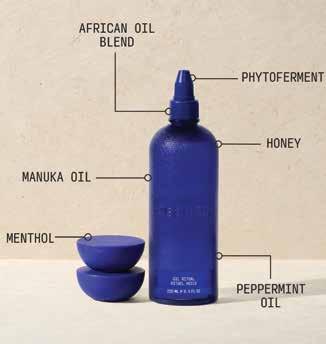
5. Oil Ritual ($48)
• A luxe treatment crafted from 21 botanical oils.
• Can be applied warm with the brand’s included applicator, or at room temperature, to deeply nourish both scalp and strands.
2. Scalp Refreshing Spray ($38)
• A no rinse formula with a slim precision nozzle to reach part lines.
• Cools, neutralizes odor, and relieves itch between washes.

4. Hair & Scalp Balm ($36)
• A balm to oil formula that soothes dry patches, seals ends, and tames flyaways.
• Can also blend leave out hair with extensions for a seamless finish.

Bundle Options: Cécred offers a Protection Collection Kit, often packaged with a Lapis travel bag and oil warmer, creating a cohesive ritual experience.
• Byrdie praised the Scalp Refreshing Spray and Detangling Spray, calling them “standout salonlevel solutions” for style upkeep and removal.
• PEOPLE magazine rated the full collection a 10/10, highlighting scalp comfort and extended style freshness.
• Early shoppers at Ulta and cecred.com give ratings in the 4.3–4.8 range, with praise for slip, cooling sensation, and scalp comfort.


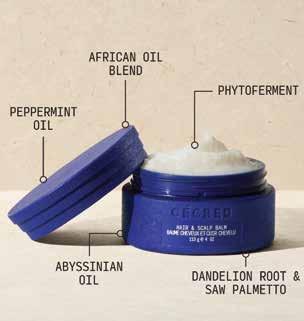
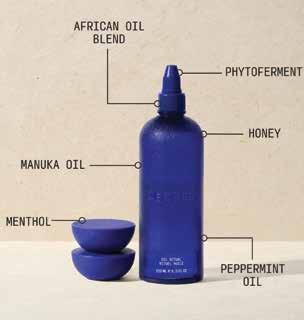
With this launch, Cécred underscores its cultural intelligence and innovation. While many luxury haircare lines stop at general hydration or damage repair, Beyoncé’s brand is carving out space for protective styles—a core practice in textured hair communities that has often been underserved by prestige labels.
By differentiating the Protection Collection from the Foundation Collection, Cécred signals a larger vision: not one ‑size ‑fits‑all care, but a modular system that respects diverse hair rituals and stages. Where Foundation builds strength and health, Protection safeguards the artistry and longevity of protective styles.
In short, the Foundation Collection was Cécred’s origin story, and the Protection Collection is its expansion pack—dedicated, precise, and visually unforgettable in its Lapis blue vessels. Together, they outline a brand not just selling products, but curating rituals of care for every chapter of hair’s journey.
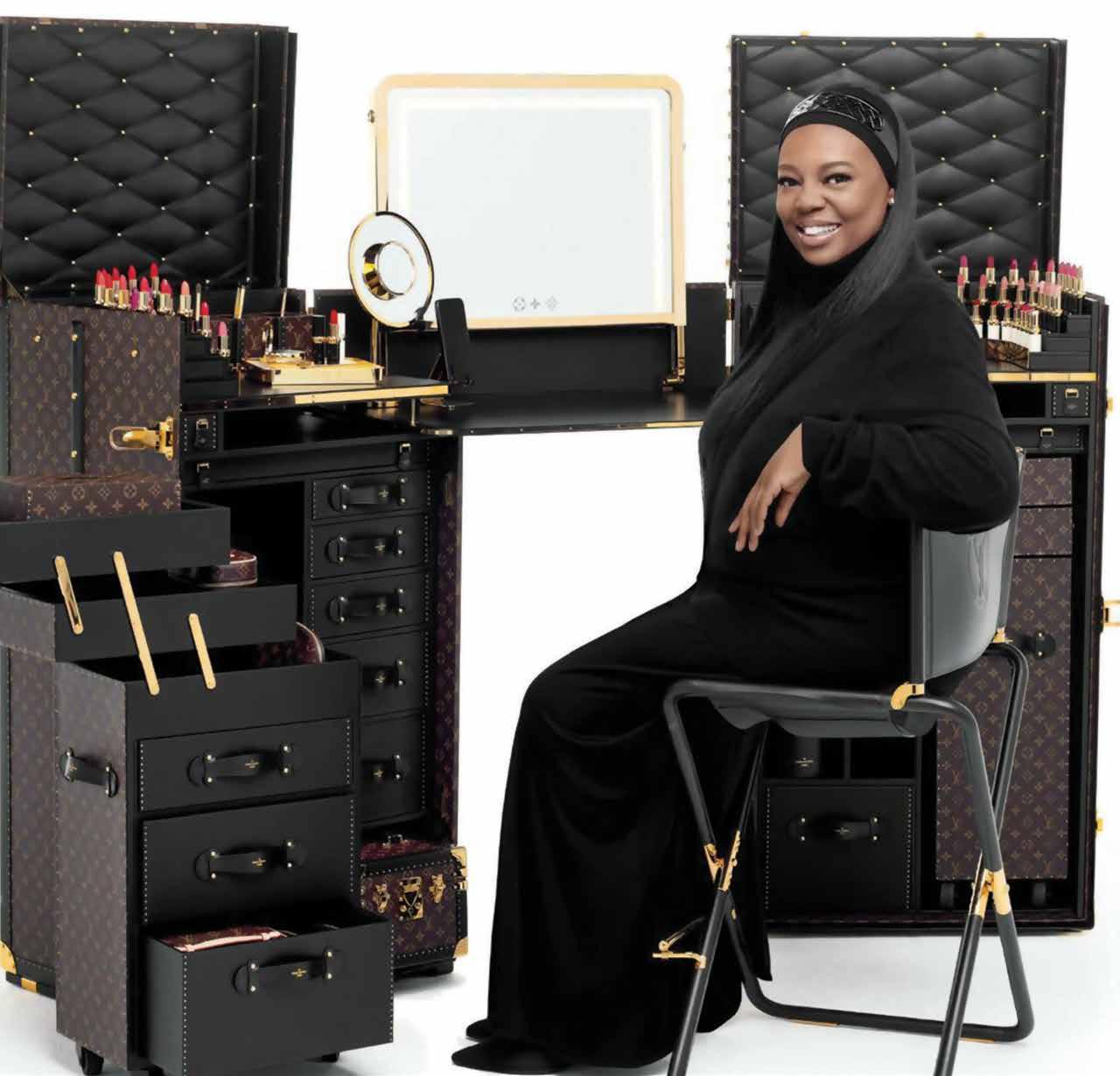
Louis Vuitton’s foray into cosmetics—branded La Beauté Louis Vuitton (or “LV Beauty”)—marks one of the boldest expansions in luxury beauty. With Dame Pat McGrath at the creative helm, the Maison is positioning its new beauty arm as an ultra-premium, art-driven extension of its fashion DNA. Here’s a closer look at why McGrath is a natural fit, what the collection offers, how it’s priced and distributed, and what might lie ahead.
Why Pat McGrath is the Perfect Pick
Pat McGrath is often referred to as the most influential makeup artist in the world—a title she’s earned through decades of pioneering texture, color, and runway innovation. She’s also someone who already shares deep ties with Louis Vuitton’s creative world, having worked backstage at Vuitton fashion shows and collaborating closely with the brand’s artistic director, Nicolas Ghesquière.
Her sensibility—obsession with detail, fearless chromatic choices, and ability to translate haute couture into wearable artistry—aligns with LV’s heritage of craftsmanship. For a fashion house known for its mastery of trunks, leather, and precision, McGrath brings legitimacy and vision to a beauty venture. In short: she isn’t just a name borrowed for glitz, she’s a genuine creative partner.

La Beauté’s debut collection launches with a curated but ambitious roster across lips and eyes. The initial offerings include:
• LV Rouge (Lipstick line) — 55 shades in total (a clever nod to the Roman numeral for “LV”). The collection is split between 27 satin finishes and 28 matte ones.
• LV Baume (Tinted lip balms / sheer finish) — 10 sheer, buildable shades designed as a softer, glowier complement to the lipsticks.
• LV Ombres (Eyeshadow palettes) — Eight quad palettes, each containing three “wearable” base tones plus one unexpected, mood-shifting color for drama.

• Beauty Accessories & Leather Goods
— As part of the brand’s DNA, the launch includes elegant cosmetic brush tools, lipstick pouches, and mini trunks or cases that echo Vuitton’s iconic aesthetic.
Notably, the packaging is refillable: lipsticks and eyeshadow palettes are designed to be kept as enduring “objects of desire,” with replaceable inserts. The cases were designed with industrial designer Konstantin Grcic, who brought minimalist, tactile sensibility to the pieces.
Formulations are positioned not just as color cosmetics but high-performance textures, incorporating skincare-like ingredients (e.g. hyaluronic acid, natural waxes, nurturing oils) and signature scents from Louis Vuitton’s perfumer Jacques Cavallier Belletrud.

Louis Vuitton has made no attempt to hide that this debut line is positioned in the very top tier. A single LV Rouge lipstick or LV Baume set (case plus refill) is priced at US $160. Eyeshadow quad palettes are priced around US $250.
Refill pricing is markedly lower: additional lipstick or balm refills are around $69. For eyeshadow refills, the rates (as per some sources) are roughly $92.
The launch is rolling out in phases. For now, the collection is sold exclusively through Louis Vuitton’s own channels—its boutiques and its official online store.
Given how Louis Vuitton and McGrath have framed this debut—not just as a product launch but as a redefinition of luxury beauty—several possibilities seem likely:
1. Expansion of Categories
After lips and eyes, we might see foundation, complexion, skincare, perfumes, brow, or even fragrance-beauty hybrids under the LV Beauty umbrella.
2. Global Department Store Placement (Carefully)
Though the brand is starting with exclusive selling channels, over time select high-end department stores (Saks, Harrods, etc.) may be allowed to carry the line under tight partnership to increase reach without diluting prestige.

3. Special Editions & Collaborations
Limited-edition shades, designer artist drop collaborations, seasonal capsule sets, and unique case finishes (e.g. special trunks or monogram art editions) are highly probable.
4. Customization and Personalization
Given Vuitton’s history with monogramming, engravings, and bespoke trunks, the beauty line could evolve services allowing clients to personalize cases, engrave initials, or customize shade mixes.
5. More Accessible Entry Points
To welcome a broader luxury-beauty audience, Vuitton might someday introduce a more accessible “core” or “essentials” sub-line — though likely still premium priced — especially if they want to entice younger consumers who see ultra-high cosmetics as aspirational.

Expect the brand to highlight more sustainable packaging, refillable mechanics, ethically sourced ingredients, and circularity messaging, reinforcing that these are timeless beauty heirlooms, not disposable makeup.
In sum, LV Beauty (La Beauté Louis Vuitton) is not a mere sidestep into color cosmetics— it’s an ambitious statement of how a luxury fashion house can reimagine the beauty
category. Pat McGrath, with her deep expertise, bold vision, and existing ties to the brand, is uniquely poised to shepherd that transition. The debut line sets a high bar with premium materials, artistic packaging, and elevated pricing. But the true test will be whether the products perform as beautifully in real life as they do in concept—and how Vuitton chooses to evolve the line in coming years. If past Vuitton ventures into perfume, leather goods, and craftsmanship are any guide, this could just be the beginning of a new Maison tradition.


As autumn’s light softens and the air cools, fragrances with warm woods, spices, leather, and amber notes feel utterly right. Below, here are 10 standout fragrances ideal for fall, spanning accessible to luxury, each with scent profiles and pricing you’ll want to test on your skin. Included is the new Hermès Barénia (Intense) we recently tried at Harrods — a perfect fall pick.


1. Hermès Barénia Eau de Parfum / Barénia Intense
We sampled this at Harrods — it’s Hermès’s first chypre fragrance, reimagined in 2025 as Barénia Intense.
• Notes: Butterfly lily, miracle berry, oakwood, patchouli, leather.
• Price/format: In the U.S., the standard Barénia EDP (100 ml) is priced around US $182. Barénia Intense is also refillable (30, 60, 100 ml) and is positioned as the “denser” sibling.
• Fall appeal: It feels beautifully wooded, leathery, and spicy — ideal for layering under a wool coat on a brisk evening.
2. Tom Ford Tobacco Vanille
A classic gourmand-woody for colder days.
• Notes: Rich tobacco, dried fruits, tonka, vanilla, cocoa, wood sap.
• Price: Roughly $300 for a 50 ml.
• Why Fall: Deep, cozy, enveloping — great for nights when you want warmth.
3. Viktor & Rolf Spicebomb Extreme
A spiced, smoky blend with plenty of character.
• Notes: Tabasco chili, leather, black pepper, nutmeg, tobacco, amber.
• Price: ~$110
• Why Fall: Spicy heat plus smoky depth makes it perfect for crisp October evenings.
4. Tom Ford Ombré Leather
Leather-forward, but not harsh.
• Notes: Leather, jasmin, cardamom, amber woods.
• Price: ~$165
• Why Fall: Leather + floral softness creates just enough contrast for daytime or evening wear.

5. Byredo
Mojave Ghost
A more minimalist, airy choice that still works in cooler months.
• Notes: Sapodilla, magnolia, violet, sandalwood, cedar, ambergris.
• Price: ~$235
• Why Fall: Its translucence lets it adapt — spring or fall, it leans warm on your skin.
6. Maison Francis Kurkdjian
Baccarat Rouge 540
A bold luminous amber-woody fragrance.
• Notes: Saffron, jasmine, ambergris, cedar.
• Price: ~$355 for 70 ml
• Why Fall: It holds beautifully — warms up over hours, leaving a radiant trail.
7. Mancera Red Tobacco
For lovers of spicy gourmands.
• Notes: Cinnamon, tobacco, nutmeg, saffron, incense, patchouli.
• Price: ~$200
• Why Fall: The spiced heart is perfect while leaves turn, pairing nicely with heavier garments.
8. Maison Margiela Replica Autumn Vibes
A cozy, woody, approachable fall scent.
• Notes: Cardamom, pink pepper, nutmeg, moss, cedar.
• Price: ~$119
• Why Fall: Evokes a walk in the woods — not too heavy, but seasonally apt.

9. Jo Malone
Scarlet Poppy
Cologne Intense
A floral‑leather hybrid with softness.
• Notes: Turkish poppy, ambrette, iris, praline.
• Price: ~$160
• Why Fall: It has enough richness to carry you through evenings without feeling overly floral.

10. Azzaro The Most Wanted Parfum
A modern spicy woody fragrance.
• Notes: Cardamom, ginger, incense, amber, woods.
• Price: ~$97
• Why Fall: Spicy warmth with smooth woods — a confident fall signature.
Tips for Choosing a Fall Fragrance & Wearing It Well
• Layer wisely. Try combining a lighter scent (like Byredo or Replica) with a deeper base (like Barénia Intense or Tobacco Vanille) on colder days.
• Pulse points in fabric layers. Apply on scarf, coat lapel, sleeve to let the scent mingle in natural heat.
• Don’t overspray. Cooler air amplifies projection; 2–3 spritzes often suffice.
• Try in-store afternoon. The skin’s warmth will reveal how the perfume evolves — especially on wood or leatherbased compositions.
Fall invites fragrance that feels tactile — smoky woods, spicy warmth, leather whispers. The new Hermès Barénia Intense fits beautifully into that niche: elegant, expressive, and perfect to explore alongside the other picks above. Let me know if you want sample-size versions or where to order any of these!
In an elegant bridge between past and present, Balmain is celebrating its 80th anniversary with a captivating exhibition titled “One Night, Eight Decades,” hosted at the brandnew Printemps New York outpost. This immersive showcase opened on September 4, 2025, marking Pierre Balmain’s founding of the house in 1945, and sets the stage for both brand heritage and contemporary vision.
The exhibition runs from September 4, 2025, with its duration expected to extend into late autumn—though an official closing date hasn’t been confirmed publicly.
General admission pricing hasn’t been openly released, but given the upscale setting at Printemps New York—a luxury department store known for curated fashion events—visitors can expect tiered access, potentially including standard entry, guided tours, and VIP packages. While pricing remains unannounced, early visitors are encouraged to check directly with Printemps New York for booking details as the exhibit progresses.
This exhibition is anything but a typical retrospective. Curated by fashion historian Julia Guillon, it stitches together 30 historical looks and 40 archival items—including sketches, early photographs, and rare ephemera—arranged in a theatrical, narrative-driven layout.
Key historical figures within the Balmain lineage—Pierre Balmain, Erik Mortensen, Oscar de la Renta, Christophe Decarnin, and current creative director Olivier Rousteing all have their creative threads woven into the exhibit’s storyline. It explores architectural

cues from Balmain’s origins, his penchant for ornamentation and gold accents, and the celebrated PB monogram that resurfaced under Rousteing’s direction in 2020.
Rousteing emphasizes the emotional significance: “Maybe what is actually new is to celebrate 80 years of a house and 15 years of a designer,” he remarked. The exhibit draws moving parallels—from Brigitte Bardot to Beyoncé—that speak to Balmain’s legacy of female empowerment and global ambition.
This marks only the second major exhibition in Balmain history—the first being a retrospective in Paris in 1985—making “One Night, Eight Decades” the most expansive U.S.-based celebration of the brand to date.
• Immerse in the Theatrical Presentation
• Navigate through eight thematic tableaux that chronicle Balmain’s evolving aesthetic, from post-war “New Look” elegance to modern pop culture references.
• Appreciate Rare Artifacts & Couture
• Marvel at archival sketches, early couture pieces, and interactive displays that offer behind-the-scenes insight into the house’s craftsmanship.
• Reflect on Legacy with Contemporary Relevance
• Observe how Rousteing positions his work within the brand’s long arc—highlighting continuity, cultural shifts, and Balmain’s future-facing intent.
• Potential VIP Experiences
• Keep an eye out for guided tours or enhanced-access packages—often available at Printemps for marquee fashion events.
The Balmain “One Night, Eight Decades” exhibition is not just an anniversary show—it’s a theatrical journey through fashion history. Framed within a bold U.S. debut at Printemps New York, the exhibit weaves together couture artifacts, visionary design, and the radiant legacy of one of France’s most enduring fashion houses. Whether you’re a fashion devotee or new to the brand, this exhibition offers a compelling, emotionally resonant experience that underscores Balmain’s past glory—and its present dynamism.





A$AP Rocky has officially launched his highly anticipated collaboration with Moncler under the Moncler Genius banner. The “City of Genius” collection—helmed by the Harlem-born rapper and creative director of AWGE— blends retro ski aesthetics with futurism, bold color-blocking, and Moncler’s signature performance outerwear.
The collection leans into “Where retro ski meets future sound,” riffing on vintage ski wear codes—like quilting, color palettes of lava red, electric indigo, bright emerald—along with trompe l’œil effects and AWGE–Moncler branding. Rocky also integrates references to his forthcoming LP Don’t Be Dumb. The result is more than outerwear; it’s statement-making gear that plays equally in fashion, music, and streetwear spheres.
Here are some of the standout pieces and how much they’ll set you back:
(Navy Blue)
Hooded Short Down Jacket (White)
Down Vest (Red)
T-Shirt (White)
down vest with bright color & signature quilting.
The collection is available now via:
• Select Moncler Genius stores globally
• Official Moncler.com site
• Luxury fashion retailers stocking Moncler x A$AP Rocky pieces (e.g. Labelsfashion, Tessabit)
Some items are marked “limited availability,” meaning certain styles/sizes are already scarce.
This collaboration cements A$AP Rocky’s continued influence beyond music, shaping fashion conversations around functionality, heritage, and performance. Pricing is steep, but the craftsmanship, bold design statements, and scarcity make many pieces collector-worthy. If you’re eyeing something from this drop, now’s the time — waiting may mean missing your size (or colorway).




LVMH is doubling down on its love affair with Rodeo Drive, unveiling ambitious new plans that could reshape the luxury landscape in Beverly Hills. After a costly hotel proposal was shot down by voters in 2023, the luxury conglomerate is now reimagining its presence with a more experiential and retail-driven approach.
Originally, LVMH aimed to build a Cheval Blanc ultra-luxury hotel on the site at 468 North Rodeo Drive. That plan, however, collided with community resistance and a 2023 referendum that killed the project.
Now, the company has pivoted to a bold new concept: a 105,214-square-foot, three-story “Louis Vuitton Rodeo Drive Experiential Flagship”, designed by Frank Gehry. This complex would span the block along South Santa Monica Boulevard between Rodeo Drive and Beverly Drive, combining retail, exhibition, a museum, restaurant, café, rooftop terrace, and VIP spaces.
The Rodeo frontage—about 45,433 sq ft—will
house flagship retail, with a reserved VIP salon and a rooftop event terrace.
The Beverly Drive side (approx. 54,723 sq ft) will host the museum/exhibition component, gift shop, café, and a 150-seat fine dining restaurant.
The exhibition components will operate by reservation only, with capped daily admissions—a “museum meets retail” model.
In September 2025, the Beverly Hills Planning Commission unanimously approved the development plan and conditional permits, clearing a major hurdle. The project’s height will max out around 60 feet, with underground parking, connecting tunnels, and pedestrian bridges joining the two wings.
Construction is expected to begin in the second half of 2026, with completion around mid-2029.
Rodeo Drive is no stranger to LVMH. Over the past decade, the conglomerate has spent nearly $1 billion on buying or leasing prime real estate there. Its existing portfolio includes Dior, Givenchy, Bvlgari, and—soon—a revamped Tiffany & Co. flagship.
The Tiffany & Co. plan is another sign of LVMH doubling down: the group submitted
proposals for a 30,466-square-foot flagship on Rodeo—right next to its existing presence— complete with a rooftop VIP lounge and dining. Industry observers interpret these moves as LVMH asserting that in the world of ultraluxury, owning rather than leasing is the only way to fully control brand experience. As JeanJacques Guiony, LVMH CFO, once remarked, “You can mention Paris, London, New York, and probably Rodeo Drive in Los Angeles … that’s about it.”

• Experiential Retail Is the Future
• In an era where e-commerce is unavoidable, LVMH is betting that differentiated, immersive physical spaces— museums, VIP salons, dining—will keep customers engaged and justify ultra-high rent.
• Cultural Branding Meets Real Estate Muscle
• The exhibition space in the Louis Vuitton building is more than decoration—it’s brand storytelling. It signals that LVMH sees its house labels not just as product lines but as cultural institutions.
• Risk, Scale, and Symbolism
• After the Cheval Blanc hotel loss, executing this new plan with broad public support is a symbolic rebound. It shows LVMH can adapt and re-enter Rodeo with ambition and local approval.
• Luxury Density and Control
• By clustering its maisons (LV, Dior, Tiffany) along Rodeo, LVMH gains economies of proximity, control over foot traffic, and synergies in high touch services.
In short: LVMH’s new Rodeo Drive plans mark not just a comeback from a thwarted hotel, but a confident bet that in the age of
Availability: The project will deliver in phases starting in 2029, with the flagship open to the public daily (though exhibition areas and dining may require reservations).
Next Moves: Watch for LVMH’s announcements on programming for the exhibition space, how often they’ll host events, and whether the café/restaurant becomes a destination in its own right.
Wider Impact: Other luxury groups will likely respond with bold store concepts, but few can match LVMH’s firepower—real estate, brand depth, and design vision all in one.
digital commerce, the flagship of the future is a theatrical campus—not just a store.
In a stirring celebration of fashion, culture, and mentorship, the Savannah College of Art and Design (SCAD) has unveiled a sweeping exhibition titled André Leon Talley: Style Is Forever. Spanning both the SCAD Museum of Art in Savannah and the SCAD FASH Museum of Fashion + Film in Atlanta, this show offers not only a retrospective of Talley’s extraordinary sartorial life, but also a deeply personal portrait of a man whose influence extends far beyond the pages of glossy magazines.

The heart of Style Is Forever lies in nearly 70 garments pulled from Talley’s personal archives— ready-to-wear, bespoke, couture, and emblematic showstoppers alike. From dramatic Met Gala coats to more quiet, intimate pieces, the display is orchestrated to reveal the many faces of a man who, towering at 6′6″, used clothing as a powerful voice. Visitors encounter the embroidered leather “Rock Style” coat by Tom Ford, the Chanel haute couture opera coat gifted by Karl Lagerfeld, and bold caftans by Dapper Dan and Patience Torlowei. Alongside these textile treasures are photographs, ephemera, and personal mementos drawn from Talley’s circle— names like Diane von Furstenberg and Karl Lagerfeld help frame the friendships and creative alliances that shaped his path.
This exhibition is more than a showcase of style—it is a bridge connecting Talley’s commitment to fashion and his devotion to education. Talley had a long-stand-
ing relationship with SCAD: he served on their Board of Trustees, curated multiple exhibitions, and supported young designers, especially students of color.
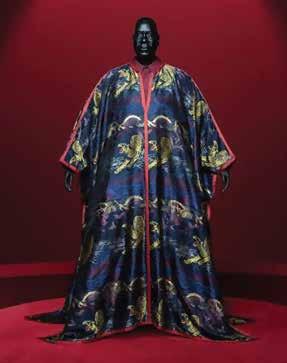
The show coincides with the 10th anniversary of SCAD’s FASH Museum, and its programming includes an accompanying catalogue featuring original essays, archival imagery, and new photography by SCAD alumnus Allen Cooley. For students walking the galleries, the experience is not merely retrospective—it is aspirational, a prompt to envision their own journeys in fashion’s evolving world.
Style Is Forever opens in Savannah on August 15, 2025, remaining on view through January 11, 2026. It then travels to Atlanta, debuting October 15, 2025, and continues until March 1, 2026 at SCAD FASH in the Peachtree Street enclave.
Talley was many things: fashion editor, cultural arbiter, raconteur, and above all, mentor. Through Style Is Forever, SCAD offers a vibrant testament to how garments contain stories, and how one man’s flamboyance, intellect, and empathy helped reshape the fashion landscape.
As visitors move through curving walls of silks, velvets, jewels, and sequins, a clearer image emerges: of a man who understood clothes as language, and used them to name identity, visibility, beauty, and power. Talley’s legacy, stitched into every thread and silhouette on display, affirms that while fashion may shift with seasons, style, at its truest, is indeed forever.

When Edward Enninful stepped away from the helm of British Vogue in 2023, many wondered what chapter lay ahead for one of fashion’s most influential voices. Now, as London Fashion Week unfurls, that next act has arrived — and in spectacular fashion. Enninful officially launched EE72 — and with it, its flagship quarterly print title 72 Magazine — with a high-profile in-store signing at Harvey Nichols Knightsbridge. The event felt at once ceremonial and revolutionary, a statement that Enninful is not just returning to print media, but defining a new frontier.
From 2 pm to 4 pm, on the ground floor of Harvey Nichols in Knightsbridge, fans, fashion insiders, and loyal followers queued to meet Enninful in person as he signed limited-edition hardback copies of 72 Magazine. The event operated ticket-free and on a first-come, first-served basis, adding an element of democratic access to what might otherwise have felt elitist. Inside, the space was curated to reflect the aesthetic ambition of EE72 — window displays featured the magazine cover alongside design objects and lighting that lent a gallery-like air to the retail environment. Enninful’s presence at the signing was more than symbolic: it reinforced his commitment to reader engagement, bridging the gap between editorial authority and public intimacy. He paused for photos, chatted with attendees, and inscribed personal
dedications — immediately elevating the moment from transactional to connective. That energy carried through the crowd, with energy, applause, and reverence as each copy was handed over.
He paused for photos, chatted with attendees, and inscribed personal dedications — immediately elevating the moment from transactional to connective.
Launched in tandem, EE72 is a new media and entertainment venture co-founded by Edward and Akua Enninful. 72 Magazine, its quarterly print edition, is positioned as a collector’s object and editorial tour de force, blending high fashion, culture, and creative voices.
A few standouts: Julia Roberts graces the premiere issue’s cover, in a conversation with George Clooney. The magazine spans 214 pages and is intentionally launched with no advertising, a move that underscores Enninful’s belief in pure editorial integrity over commercial compromise. Contributors include cultural luminaries across fashion, art, beauty, and thought leadership, uniting global voices under a shared creative ethos.

In media commentary, 72 is being framed as a direct counterpoint to the traditional magazine model. The Guardian notes that after Enninful’s high-visibility exit from British Vogue, launching 72 signals a rebirth — and a bold statement about the future of print. Print, he argues, “has become more powerful than ever,” a tactile art form rather than a relic.
Because he is no longer tied to legacy constraints, Enninful can experiment — in format, in narrative, in partnerships — unbound by conventional hierarchies. For creative and media observers, EE72 positions him as an entrepreneurial visionary, not simply a former editor returning to the fold.
This London launch isn’t just a glitzy fashion moment. It is the public affirmation of Enninful’s metamorphosis: from Vogue’s
steward to media auteur. He has carried forward his editorial gravitas and relationships, but refocused them into a vehicle that centers creative control, inclusivity, and boundary-pushing storytelling. Seen in that way, the Harvey Nichols signing was a ritual of ownership — of narrative, of legacy, and of a future he’s choosing to write on his own terms. For Londoners, for fashion watchers and culture lovers, the document of 72 is now in hand. But its significance lies as much in what it promises as in what it publishes: a new standard for what magazines can be in 2025 and beyond. Special thanks to Edward, for personally signing our copy of 72 Magazine. Your gesture turned an already thrilling launch into a cherished moment. We couldn’t be more proud of you and continuing to support as we move forward.


London Fashion Week Spring/Summer 2026 was a spectacle of reinvention, heart, and unabashed creativity—and we were absolutely delighted to attend. London is one of our favorite weeks of Fashion Month, and this season proved once again why its energy is unmatched: adventurous, inclusive, forward-thinking. Over four days, the city pulsed with fresh voices, dramatic staging, and boundary-pushing collections that set the tone for the season ahead.
Under the new leadership of British Fashion Council CEO Laura Weir, this edition of LFW felt charged with possibility. Show fees were waived to lower barriers for emerging talent, and the spotlight broadened to include designers who are reshaping fashion from the roots. The result? A lineup that balanced heritage names with bold newcomers, creating a dialogue between legacy and discovery.
Burberry’s closing show at Kensington Palace Gardens was a true high note—music, exuberance, and bold silhouettes made it feel like a festival in haute couture. Nanushka made its London debut with “The Weave,” a Cuban-inspired collection that fused craftsmanship and lively prints, leaving us with a long wish list. Conner Ives embraced pop culture flamboyance with neon, feathers, and fluid movement, turn-
ing the runway into a manifesto of expression and joy. Simone Rocha reasserted her voice in romantic, textured statements of girlhood and quiet rebellion. And Ahluwalia’s “Affinity” showed emotional intelligence through cultural motifs, draping, and strong tailoring—proof that storytelling remains essential.
Across the board, trends surfaced that felt both rooted and daring: fringing in bold placements, citric and neon color accents, layered jersey constructions that are wearable and spirited, and an undercurrent of sustainability in remixing textiles and reworking craft.
What makes London extraordinary is its spirit of risk without apology. Here, a debutant can strut alongside an established icon, and audiences celebrate both equal parts. The openness to experimentation—whether in form, narrative, or material—gives London a distinct personality in the rotation of Fashion Month. We felt it firsthand: in backstage laughter, runway anticipation, and the electric hum when a new designer lands a bold idea.
We are thrilled to share some of our favorite collections from this unforgettable week in the following pages—each one a beacon of ambition, artistry, and the kind of fashion that reminds us why we love to attend.


Four months have passed since the Met Gala 2025, whose theme Superfine: Tailoring Black Style invited the world into a history often overlooked yet always present: the artistry, elegance, and defiance embedded in Black tailoring. That night was never just about clothes; it was about power who gets to define elegance, whose heritage is archived, and whose work is finally acknowledged in spaces that have long excluded them.
The Gala was historic in its visibility. Twelve Black designers, from established veterans to emerging voices, dressed A-list attendees, shifting the conversation from “who wore what” to “who made it.” For once, authorship, craftsmanship, and cultural storytelling took centre stage.
Yet the night also drew critique. Some argued that the vibrancy and defiance central to Black dandyism its flair, social commentary, and refusal to conform were flattened into elitist aesthetics. “I wanted to see more colour, more vibrancy. Dandyism is about creating a story,” one commentator lamented, underscoring the danger of spectacle without substance.
The accompanying Costume Institute exhibition, Superfine: Tailoring Black Style, provided crucial context beyond the flashbulbs. It traced how Black communities have historically used tailoring to assert dignity, autonomy, and individuality in societies designed to deny all three. From Harlem zoot suits to Caribbean dandyism, tailoring was


never neutral: it was political, poetic, and profoundly personal.
Still, the industry remains caught between reverence and reduction. For every designer elevated, others were overshadowed by attendees who favoured surface-level nods over cultural depth. The gap between wearing the clothes and understanding the culture became starkly apparent.
Yet disappointment can be fertile ground. Within creative circles, frustration quickly gave way to action.
This is exactly where London Fashion Week 2025 picked up the thread. Designers such as Labrum London, Bianca Saunders, and Nicholas Daley are proving that tailoring rooted in Black heritage is not a fleeting trend but a living archive. Among them, Labrum’s
Foday Dumbuya staged perhaps the most resonant show of the season. His collection, titled Osmosis, was more than a fashion presentation — it was a cultural counternarrative, timely, urgent, and deeply tied to the politics of belonging.
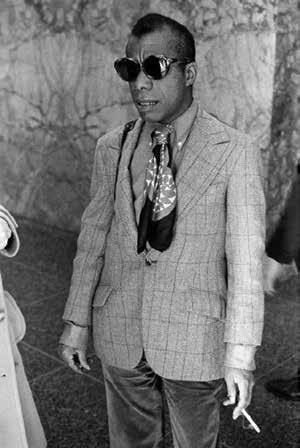
“Osmosis,” Dumbuya explains, is about “the dissemination of culture and its ability to influence all that surrounds it.” On the runway, that
idea took tactile form. Cowrie shells — once currency, always spiritual symbols — adorned garments and headwear, reminding audiences of diasporic continuity and value systems predating colonial hierarchies. A ventilation block print, referencing architectural forms common across African and Caribbean homes, became a metaphor for permeability and breathing space: culture flowing even through the cracks.
The show’s sonic dimension, created with the Balimaya Project, deepened this metaphor. West African polyrhythms met jazz, soul, and spoken word, transforming the runway into a ritual of cultural exchange. Structured tailoring — sharp blazers, military silhouettes — stood alongside natural fibres and ceremonial headpieces, visualising the tension between restriction and freedom, authority and adaptation.


This was not mere aesthetic play. It was political. Osmosis unfolded just as far-right protests in London amplified anti immigrant rhetoric. Against this backdrop, Labrum’s runway asserted another version of Britain: one defined not by exclusion but by hybridity, permeability, and creative resilience. Where the Met Gala offered a flash of visibility for Black tailoring, Labrum insisted on depth, continuity, and defiance.
Here, the show connects directly to the legacy of Black dandyism. From Harlem’s zoot suits to Caribbean flamboyance, dandyism has always been about more than clothes. It has been a means to claim dignity and individuality in societies determined to deny both. At its core, dandyism is osmosis: remixing cultural codes, inhabiting elegance as both shield and performance, demanding presence in spaces that would rather look away.
Labrum embodies that legacy in the present moment. The sharp lapels, jewel toned linings, and fluid reworkings of suiting nod to Black tailoring’s artistry and defiance. Yet unlike the Met Gala’s rarified staircase, Labrum’s stage is porous, communal, and resistant to elitist dilution. It reminds us that dandyism’s legacy is not locked in archives it lives in London’s streets, in diasporic communities, and on runways that refuse to separate politics from aesthetics.
The Met Gala lit a fuse. Osmosis shows what happens when the conversation moves from spectacle to execution. Visibility alone is not enough; authenticity, storytelling, and structural opportunity must follow. If the industry is serious about honouring Black tailoring, it cannot stop at red carpets. It must look to designers like Labrum, who turn tailoring into testimony layered, hybrid, and profoundly alive.

In the grand halls of Ladbroke Hall, a revolution in storytelling unfolded under the soft glow of spotlights. The Unity in Design Global Network (UDGN) — founded by designer and British Fashion Council member Tare Isaac — brought together 16 designers from across the African and global diaspora for Cultural Threads SS26, a runway show that refused to separate beauty from belonging.
Coordinated by Black PR, the showcase pulsed with life — a sensory tapestry of color, ritual, and reclamation. It wasn’t just a catwalk; it was a cultural call to remembrance. Here, garments became vessels of memory, and the runway transformed into a living archive of identity. UDGN’s mission is as radical as it is necessary: to reimagine the fashion ecosystem through the lenses of underrepresented designers, offering business mentorship, wellness care, and visibility through an incubator-to-showcase model. For Isaac — of Ijaw descent — UDGN is more than a platform. “It’s the bridge I once needed,” she says. “A space where our stories are not just seen, but centred.”

Each designer brought a distinct thread to the narrative. MOTUNRAYO’s Of Water and Spirit channeled the sacred Osun Festival in a cascade of gold and fluid silk; AYAH’s The Fisherman’s Echo rippled with textures drawn from the Niger Delta’s flowing rhythms; ZUBERE’s ULO NWAANYi – The Woman’s Homecoming celebrated the power and poise of the Igbo bride.

RAY CHU’s Homage to the King reimagined Yoruba nobility through precise tailoring and opulent form, while ROBES AND BLINGS BY AKOKOMALI turned the purity of white cloth into an emblem of resistance and rebirth. Isaac closed the show with her own label, TWIN by Tare Isaac, and The Water Bearer — a beaded, oceanic hymn to the Ijaw people’s relationship with the sea. Audience members — among them editors, stylists, and cultural commentators — called the evening “a watershed for representation at Fashion Week.” More than a show, Cultural Threads felt like a homecoming. It reminded the fashion world that innovation and heritage are not opposites but intertwined — each stitch, each step, an act of reclamation. UDGN has not just entered the fashion conversation. It has rewritten its language.
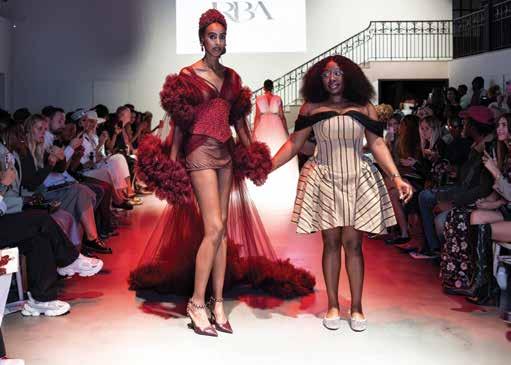
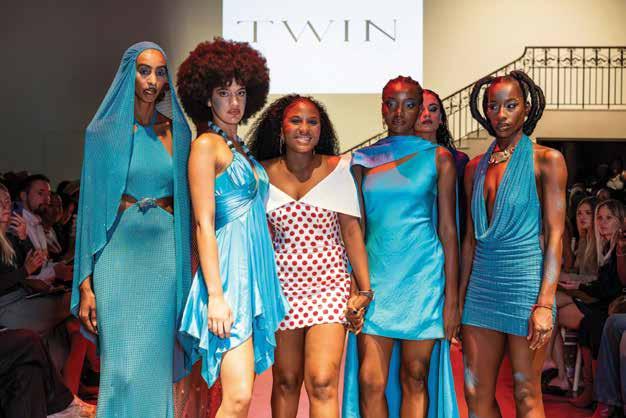
Emerging from London’s creative crucible, Soramame’s Spring/Summer 2026 collection— aptly titled “Sparkles of Momentum”—charted a compelling new direction for the Vietnamese couture brand. Revealed at Devonshire Square under the auspices of Oxford Fashion Studio, the line carved a space between glamour and grit, weaving themes of impermanence, urban function, and refined sensuality into each design.
At the heart of Soramame’s vision is a poetic tension: the meeting of “everything and nothing,” as the designer describes it. It’s not a statement about emptiness as void, but as potential. The collection taps into that potential through movement, light, and a material language that suggests both presence and transience.
The setting spoke to this ambition. Devonshire Square—with its industrial past and ever-changing face—became an echo chamber for Soramame’s narrative. Historically, the square housed craft workshops; this season, it housed creations that
married streetwear utility with couture sensibility.
Sparkles of Momentum opened with Grecian drapes and fluid gowns shimmering in metallics, anchoring the collection in high glamour. But beneath that polished surface was versatility. Many pieces carried updated streetwear elements—caps, sunglasses, asymmetrical layering—designed to carry wearers from day into night without missing a beat.
Animal prints appeared, layered beneath sheer panels or contrasted with structural leather boots, injecting a bold energy. Meanwhile, dramatic cut-outs and shifts in material—such as mixing satin, mesh, and woven textures—kept every look distinct while preserving cohesion.
One of the collection’s strengths is how it balances elegance with street attitude. Look at the sequined opal floor length gown: under strong light, it glows like a couture statement— but styled with bold boots, it transforms into a piece of city armor. The juxtaposition of sculptural lines and soft drape, ornament and structure, runs throughout.
Soramame shows that modern glamour doesn’t have to abandon function. Their design approach allows for garments that are experiential and expressive, yet wearable. In Sparkles of Momentum, each look feels like a statement and an invitation— step in, move through, let the fabric live with you.

With this SS26 collection, Soramame stakes a firm claim as a brand to watch. Their voice is bold but grounded, speculative but tethered to the realities of how we live and move. Sparkles of Momentum isn’t just a show—it’s a manifesto of motion, light, and modern identity.
In a dazzling display of creativity and cross-cultural collaboration, Taiwan’s Ministry of Culture brought a distinctly Taiwanese vision of contemporary design to London this week. Curated by the acclaimed Rain Wu, the showcase united four of Taiwan’s most innovative fashion talents
— APUJAN, INFDARK, JENN LEE, and RAY CHU — in a one-of-a-kind sensory experience that blurred the boundaries between fashion, food, and art.
Staged at the Institute of Contemporary Arts (ICA) — one of London’s most iconic venues for avant-garde expression — the event transformed the Brandon and Nash Rooms into an immersive world where fabric met flavor and design met emotion. Each designer’s collection was paired with a bespoke culinary creation from BAO London, extending their artistic narratives from runway to plate. Scenography and florals completed the experience, echoing Taiwan’s deep-rooted respect for nature and its commitment to sustainability.
APUJAN captivated guests with ethereal knitwear and chiffon gowns inspired by the realms of fantasy and time, merging storytelling with fine craftsmanship. INFDARK reimagined traditional Taiwanese motifs through a futuristic lens, fusing heritage with a bold, urban sensibility. JENN
LEE, marking a milestone anniversary, unveiled a transformative collection that married gothic edge with romantic undertones, a reflection of her boundary-pushing ethos. Meanwhile, RAY CHU continued his mission to redefine gender expression through fashion, presenting fluid tailoring crafted from upcycled materials — including tea leaf fiber and fish scale waste — exemplifying Taiwan’s sustainable innovation. Guests from across the fashion and cultural sectors — including representatives from the British Fashion Council and international press — praised the event as “a truly remarkable sensory experience… far beyond a traditional showroom.”
More than a showcase, the evening served as a manifesto for modern Taiwanese creativity: emotionally intelligent, environmentally conscious, and fearlessly experimental. Through the synthesis of texture, taste, and technology, Taiwan’s new generation of designers proved that fashion can be as much about feeling as it is about form.
In bringing together design, gastronomy, and artistry, this event not only celebrated Taiwan’s vibrant cultural identity but also demonstrated how fashion can transcend the visual to engage every sense — leaving an indelible impression on London’s creative landscape.

In a season brimming with established names and bold comebacks, Josh Birch Jones’s SS26 presentation felt like a breath of assured youth. At just twenty, Birch Jones continues to defy expectations—already the youngest member of the British Fashion Council—and his latest collection underscores that maturity is not measured in years but by clarity of vision.
From the moment the first look appeared, there was no mistaking the designer’s distinctive voice. The collection moved seamlessly between structured elegance and soft modern femininity. Crisp suiting with exaggerated lapels and cinched waists sat next to fluid chiffon gowns and dresses with gentle draping. The tension between control and ease established the emotional core of SS26: every strong line balanced with a whisper of movement. What sets Birch Jones apart is how these contrasts never feel forced. His tailoring feels livedin, his eveningwear confident but not rigid. As he explained in a recent profile: “I think about her whole day—where she’s going, how she moves … that’s what drives every decision.”
The color story of SS26 felt intentional and rich. Neutrals—ivory, dove gray, soft taupe—provided a


steady foundation. Into that framework, bursts of terracotta, sapphire, and moss green danced, giving life and depth without overwhelming. Textures played beautifully across the collection: matte crepes, softly ruched silks, and whisper-thin mesh panels created layers of complexity.
Standout details elevated every piece. Corset-style bodices peeked from under blazers. Sheer sleeves, when layered over solid underpinnings, suggested lightness without exposure. Metallic hardware was used sparingly—often as an accent belt or refined clasp—so its impact leaned subtle but memorable.
Birch Jones staged the presentation with the confidence of someone who knows his strengths. The pacing felt deliberate: no rush, no spectacle, just a sequence of ideas that unfolded with quiet insistence. The audience recognized it—the applause was steady, softly insistent, a sign that a new perspective in couture is being welcomed, not tolerated. This SS26 collection does more than confirm Birch Jones as a rising talent—it positions him as a voice already in command. His work seems to ask: how can elegance feel modern again? How can clothes celebrate strength without rigidity? On this showing, Josh Birch Jones answered both with authority.
Balmain’s Spring/Summer 2026 show felt like a voyage—one that sailed between opulence and ease, shell-laden glamor and bohemian breath, ornate craft and untethered movement. Under Olivier Rousteing’s direction, SS26 channeled a nuanced reset: softening the house’s signature armor while doubling down on its innate drama. Set in the InterContinental Hotel’s soaring ballroom, a space familiar from Rousteing’s earliest days at Balmain, the runway became a cathedral of light and texture. The opening sequences offered a visual cue to the season’s mood: garments embroidered with ethically sourced seashells and wooden beads, cascading like tidal edges across dresses and jackets. It was beauty drawn from nature, reimagined through couture precision.

Rousteing took steps toward softness. Sharp shoulders remained—but now as “action shoulders,” gently relaxed, giving shape without rigidity. Drop-armed leather blousons and deconstructed tailoring joined fluid silks and satins. Some looks wore classic Balmain codes—structured bodices, corsetry—but in dialogue with drapery, cowl necklines, and unfixed volumes.
The palette followed the mood. Muted neutrals— sand, ivory, taupe—dominated, grounded by occasional flashes of deep sapphire, rust, and


coral. Surface details came alive through texture: bead-trimmed hems, layered fringe, embroidery that felt both organic and intentional. Ethereal maxi dresses, sheer overlays, and belted robes felt alive with suggestion rather than display. Standout accessories underscored the spirit. Handbags swathed in shells became statements of subtle ornament, echoing the clothing. Strappy sandals and boots with carved detailing anchored the looks without overpowering them. Even the most sculpted pieces never felt overdone—they respected space and breath. What made Balmain SS26 resonate is how Rousteing negotiated tension. Instead of an antagonism between strength and softness, he wove them together. The result: glamour that feels lived in, precision that allows flexibility, couture that invites movement. It was Balmain renewed—not by abandoning its roots, but by allowing them to flex into new form.
In a season of “new eras,” Rousteing reminded us: evolution need not mean erasure. Balmain’s SS26 proved that the heart of a house can be remade—not by abandoning its identity, but by trusting it to grow.
the Intimate Ballet of Self
Nicolas Ghesquière has always danced at the intersection of the architectural and the ephemeral—and his Spring/Summer 2026 for Louis Vuitton was another graceful leap forward. In a season where many houses opted for spectacle, Ghesquière chose a different path: he turned inward, highlighting the elegance of solitude, the poetry of private moments, and the tension between fragility and armor.
The show was staged inside the Louvre’s former apartments of Anne of Austria—gilded rooms, ornate moldings, and a centuries-old intimacy recontextualized as a runway. The decor, curated by Marie-Anne Derville, merged Art Deco seating with 18th- and 19th-century touches, creating a layered environment that felt like wandering through a series of private salons. Nearly every element of the presentation reinforced Ghesquière’s vision of fashion as a form of personal ritual, rather than pure performance.
The show opened quietly, almost hesitantly, with sheer, weightless layers—silks and chiffons traced with subtle piping, skimming contours rather than clinging. Corseted bodices emerged soon after, structured at the waist before dissolving into ruffled edges. Skirts floated like vaporous clouds. The tension between the precise and the drifting became the collection’s emotional core: strength softening into softness, guard lowering into grace. As the runway progressed, Ghesquière amplified his voice. Draped bombers, embroidered pieces, and crystal-encrusted jackets took a more assertive posture. There were beaded gowns that evoked spring landscapes, layered lace accenting denims, and asymmetric dresses that defied convention.
Neutral stone tones dominated early in the show—ivory, sand, and cement—underscored by occasional bursts of dusty rose, powder blue, and muted amethyst. Texture was Ghesquière’s true palette: lace, sheer layers, shearling trims,

and sequined embroidery all played into the sensory depth of the collection.
Accessories felt integral, not afterthoughts. Gold chain belt-watches, reworked Sneakerinas, and clutches tailored to the newly launched La Beauté makeup line reinforced the interplay between utility and fantasy.
What made this collection resonate was Ghesquière’s ability to hold dualities without collapsing them. His SS26 Vuitton was about the architecture of the self—how we dress for the parts of us unseen by the public, how we present our inner lives outwardly. It wasn’t a show about extremes but about balance: strength shimmering beneath translucence, heritage refracted through modernity. In a moment when many houses are redefining themselves, Nicolas Ghesquière offered a quiet declaration: that fashion’s most profound statements sometimes speak in whispers, not roars.
Louis Vuitton’s Spring/Summer 2026 collection landed as a soft revolution—part introspective whisper, part quiet assertion. Under the steady hand of menswear creative director Pharrell Williams, SS26 embraced a vision of refined comfort, cultural hybridity, and subtle grandeur. Walking the line between restraint and resonance, the show revealed a Vuitton ready to evolve without shedding its core identity.
Rather than overwhelming spectacle, SS26 leaned into the idea of home—the internal, the lived-in, the intimate. Knitwear and silk linens, pajama-inspired trousers, robe-like coats, and cardigans with generous pockets dominated the runway. Models moved as though in memory or dream, not performance, reinforcing an aesthetic of ease over exertion.
Still, there was refinement in the calm. Tailoring softened: jackets layered over relaxed separates, waistcoats worn under open coats, proportions subtly shifted to create gentle silhouettes. The result was an understated elegance that felt modern and humane.
The collection’s quiet luxury was enriched by exchanged references, especially India. Textiles

echoed embroidery traditions, tonal washes suggested sun-bleached streets, and design elements—such as cricket stripes—reimagined colonial-era cliques in a liberated, postcolonial frame.
Set on a monumental “Snakes and Ladders” board outside the Centre Pompidou, the runway itself became metaphor: movement, chance, ascent, and descent. Collaborating with Studio Mumbai, Williams created a space of ritual and reflection, one where garment, wearer, and environment speak.
Restraint did not mean dullness. Soft palettes of sand, cream, rust, and muted purples were punctuated by faded denim, metallic shells, and translucent layers. Denim sets were treated with lived-in washes; sheers and lace appeared under structured coats.
Accessories carried the ethos of the clothes. The Speedy P9 bag debuted in new finishes. Sculptural footwear, embroidered trunks, and minimalist hardware emphasized purpose over ostentation. What made SS26 especially compelling was its conviction. Louis Vuitton didn’t shout. It listened. It whispered. In those whispers, Williams delivered a collection rooted in intimacy but projected outward with quiet force. This wasn’t fashion as drama—it was fashion as resonance. The Vuitton wardrobe of tomorrow looks like the clothes you’ll live in, the stories you’ll carry, and the canvas you’ll wear.


Few fashion houses carry the legacy of provocation and power quite like Mugler. With its sharp tailoring, sensual silhouettes, and theatrical flair, the brand has long defined what it means to be daring. For Spring/Summer 2026, all eyes turned to Miguel Castro Freitas as he unveiled his first collection for the house. His debut did more than live up to the moment—it electrified it, signaling a bold new era for Mugler.

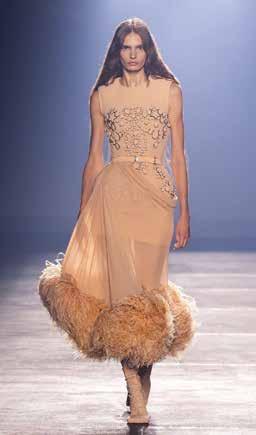
Taking the reins of a house with such a distinct identity is no small feat. Yet Freitas approached the task with precision and vision. He honored Mugler’s iconic codes—corseted waists, sculptural shoulders, and futuristic tailoring—while filtering them through his own perspective. The result was a collection that felt both reverent and revolutionary, carrying Mugler’s DNA into uncharted territory. The opening looks set the tone: razor-sharp bodysuits in jet black, punctuated by flashes of chrome hardware and sheer paneling. These were power uniforms, commanding the runway with unapologetic confidence. Yet woven through the collection was a sense of fluidity—draped silks, cut outs that revealed skin in unexpected ways, and tailoring softened by sculptural curves. It was Mugler as armor, but armor designed to move.


The color story oscillated between stark minimalism and bold futurism. Sleek monochromes—black, white, silver—dominated the runway, punctuated by shocks of neon violet and electric teal. This interplay amplified the collection’s tension between strength and sensuality. Materials, too, reinforced this duality: lacquered leathers and metallic mesh contrasted with translucent organza and liquid silks. Accessories leaned into exaggeration, a Mugler signature. Oversized eyewear, chrome-plated belts, and sky-high boots added impact, while sculptural handbags played with geometry and proportion. Each element underscored the collection’s vision of fashion as performance.
Freitas’s debut wasn’t just about clothes—it was bout declaring intent. His Mugler woman was fierce, futuristic, and free, embodying power without sacrificing vulnerability. The show itself, staged in a cavernous industrial space with stark lighting and pulsing sound, emphasized the energy of transformation and reinvention.
As the final look—a fluid silver gown sculpted to the body like molten metal—swept across the runway, the audience erupted. The standing ovation was not just for a strong collection, but for the arrival of a designer who had managed to channel Mugler’s spirit while making it entirely his own.
Miguel Castro Freitas’s debut for Mugler was nothing short of a triumph. Bold, seductive, and visionary, it set the stage for a thrilling new chapter in the house’s storied history. The message was clear: the future of Mugler is electric.
The anticipation surrounding Dior’s Spring/Summer 2026 show was unlike any other this season. For the first time, Jonathan Anderson unveiled his vision for the storied French house, and the result was a daring redefinition of Dior’s codes for a new generation. Known for his ability to fuse intellectual playfulness with sculptural modernity, Anderson’s debut delivered a fresh vocabulary of luxury—one that honored Dior’s heritage while fearlessly pushing it forward.
Christian Dior’s legacy has always centered around femininity, elegance, and the iconic “New Look.” Anderson embraced this foundation but interpreted it through his own irreverent lens. The collection opened with architectural tailoring— sharp jackets nipped at the waist, paired with voluminous skirts that nodded to Dior’s 1947 silhouette. Yet Anderson infused the shapes with an unexpected edge: asymmetrical cuts, exaggerated proportions, and innovative fabric treatments that made tradition feel strikingly modern. The interplay between structure and fluidity was central to the collection. Silk organza dresses cascaded with ease, while sculptural knitwear hugged the body like second skin. It was a dialogue between past and present, rigor and play—a duality that Anderson has long mastered in his namesake label.


Color was used with precision. Classic Dior tones—black, ivory, blush—were punctuated with jolts of high-energy hues: electric lime, cobalt, and crimson. These injections of boldness felt like Anderson’s signature handprint, a reminder that Dior’s elegance need not be confined to muted restraint.
Accessories, too, spoke to reinvention. The iconic Lady Dior bag appeared in deconstructed forms, with playful cut-outs and experimental materials, while footwear ranged from sculptural heels to minimalist sandals. Jewelry, oversized yet refined, framed the looks with a sense of modern armor.
What made this debut remarkable was its clarity. Anderson did not shy away from the weight of Dior’s legacy; instead, he leaned into it, using the house’s foundations as a canvas for innovation. His Dior was cerebral but sensual, rebellious yet respectful—a vision that felt entirely of our time. The audience’s reaction was electric, with a standing ovation that confirmed Anderson had not only met expectations but surpassed them. His debut was more than a fashion show; it was a cultural moment, signaling a bold new chapter for Dior. Jonathan Anderson’s Spring/Summer 2026 collection marked the beginning of a thrilling era for Dior. By blending reverence for heritage with fearless experimentation, he redefined what luxury can look like in the modern age. This was not just a debut—it was the dawn of a new Dior.
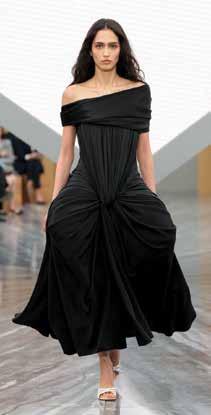


Few houses in fashion embody subtle luxury quite like Bottega Veneta, and the Spring/Summer 2026 collection marked the beginning of a thrilling new chapter. With Trotter stepping into the role of creative director, the anticipation’s was sky-high. How would the designer translate Bottega’s storied codes—stealth, texture, and artisanal excellence—into a vision of modern relevance? The debut answered with confidence: a collection that radiated quiet power, quietude elevated into something astonishingly fresh.
From the outset, it was clear that Trotter intended not to erase but to evolve. The opening looks spoke directly to Bottega’s heritage: buttery leathers rendered into impeccably tailored coats, woven intrecciato detailing reimagined on oversized totes, and a simplicity of line that conveyed understated authority. Yet layered within this foundation was a new vocabulary—architectural silhouettes, unexpected draping, and an embrace of asymmetry that lent the collection an edge. The interplay of structure and fluidity defined SS26. Sculptural jackets were paired with languid trousers, while dresses in translucent silks seemed to ripple with movement. Each piece carried Bottega’s hallmark of exceptional craftsmanship, but reframed for a world that prizes individuality as much as polish.

The palette was deliberate, almost meditative: earthy neutrals—stone, sand, and moss—were punctuated by jolts of saffron, petrol blue, and deep plum. This restraint allowed texture to take center stage. Supple leathers, knotted raffia, and handwoven fabrics invited the eye to linger on detail. Even accessories became a study in tactility: oversized clutch bags in padded leather, geometric sandals with braided straps, and jewelry that felt sculpted rather than ornamental.
What made Trotter’s debut resonate most was its clarity of purpose. It didn’t chase spectacle. Instead, it celebrated intimacy, craft, and longevity—values deeply embedded in Bottega Veneta’s DNA. Yet there was also a freshness, an energy that signaled a designer keenly attuned to the present moment. It was luxury for those who appreciate nuance over noise, statement through stillness.
As the final look swept the runway, the audience’s response was unmistakable: this was a triumph. Trotter not only honored the essence of Bottega Veneta but charted a course for its future. The SS26 debut was proof that true luxury lies not in shouting the loudest, but in whispering with conviction.
Bottega’s new era has arrived—subtle, assured, and powerfully compelling.


When Haider Ackermann took the helm for Tom Ford’s Spring/ Summer 2026, the runway became a nocturnal dreamscape— sleek, seductive, and charged with tension. With his signature eye for control and edge, Ackermann transformed the essence of Tom Ford into something darker, more fluid, infinitely magnetic. From the first look, the collection established its rhythm: verticality and precision, silhouettes carved with architectural rigor yet interrupted by unexpected sensuality. Trench coats buttoned to the chin, sculpted tailoring, and high-shine surfaces gave nods to the brand’s classic codes— then Ackermann whispered them into the night with slits, sheer panels, and bare skin.

Ackermann called his inspiration “a midnight swim,” a moment
that feels dangerous, secretive, intimate. The runway set, a deep blue lacquered floor, acted like water underfoot—reflecting models who moved as though submerged, slithering through space with deliberate slowness. The effect: seduction as a game, tension disguised as elegance. Colors shifted between abyssal tones and vivid punctuation. Navy, black, and silver anchored the collection, but bursts of lime green, baby pink, pastel mint, and pool blue fractured the night like neon flares. On some pieces, the contrast heightened the ambiguity—was this lingerie or outerwear? Was this suit or skin? Ackermann blurred boundaries.

One of the most striking tensions in the collection was between structure and release. Rigid jackets and corseted bodices gave way to dresses that defied gravity—straps sweeping across bodies, skirts looping like sinew, cut-outs suspended
with wire frames. The designs teased revelation without giving away everything—a lesson in control.
In other moments, sheer shorts, micro-lingerie visibilities, and translucent layering reimagined nightwear as high fashion. Elsewhere, laser-cut patent leather and glossy finishes caught the light, echoing the show’s aquatic ambiance.

Ackermann didn’t just borrow Tom Ford’s seductive DNA— he re-engineered it. Models were directed to flirt with the audience, to court their attention with glances, posture, presence. The attitude was as essential as the clothes: confidence wrapped in mystery. By the time the finale arrived— smoke, silence, silhouettes against the glow—the audience could only surrender to the spell. Tom Ford SS26 proved that in the hands of a visionary, seduction becomes architecture: deliberate, crafted, and unforgettable.
Paris—under a smoky hush and electric tension—once again reminded the world why it remains the beating heart of fashion. This season’s Spring/Summer 2026 runway offerings proved more than a résumé of names; they were statements in identity, legacy, and reinvention. Among them, Balmain, Mugler, Tom Ford, Rodarte, Louis Vuitton, Dior, and Schiaparelli stood out for boldly channeling history while reimagining the future.
Balmain opened with its “Continuum” collection, riffing on the house’s emblematic strength and structure but softening the edges with unexpected fluidity. Sharp tailoring met sweeping drapery, and armor-like corsetry bowed to romantic silhouettes in a dialogue of power and vulnerability.
Mugler, reborn under Miguel Castro Freitas, pushed sensual geometry to dramatized extremes. His debut interpretation combined daring cutouts, sculptural forms, and exaggerated proportions, anchoring glamour in architectural rigor. At times the pieces felt like living sculptures.
At Tom Ford, new creative voice Haider Ackermann embraced sultry night-scape fantasy. His runway played like a film: models moved like seductors through shafts of light, in patent leathers, sheer panels, and suspended constructions that flirted with gravity. Tension and elegance entwined.
Rodarte, known for its poetic nuance, delivered a quieter counterpoint. Delicate layers, deconstructed florals, and soft palettes evoked a dreamlike daydream. While less overt than some peers, Rodarte’s show reminded us that emotional texture still matters in high fashion.
Louis Vuitton staged its residency within the Louvre’s historic apartments, merging domestic intimacy and haute couture spectacle. Nicolas Ghesquière resurrected the archival LV I timepiece as a chain-belt accent, tying together heritage and modern grace.
Dior’s moment was especially charged—Jonathan Anderson’s first full womenswear vision. He echoed Dior’s “New Look” codes—cinched
waists, flared skirts—but fractured them with asymmetry, bows in suspension, and textural riffs. The result: an era to era conversation, not a rewrite.
Schiaparelli, always the surrealist provocateur, leaned into body as canvas. Daniel Roseberry’s mesh deconstructions, daring silhouettes, and conceptual subversions echoed Elsa’s legacy of surprise. The black-sand runway backdrop sharpened the drama, making each dress a miniature theatrical moment.
Across all these houses, a few currents wove themselves visibly through the season: ultra-skinny belts, tonal pinks and lilacs, and the flirtation between structure and erosion. But more than trends, this Paris edition felt like a turning point— designers reckoning with their archives while pushing toward raw, present-day relevance.
In a city built on memory, the runway was the boldest channel yet: a place where history speaks forward, where reinvention is not betrayal, and where fashion becomes more than clothing—it becomes manifesto.

Paris Fashion Week Pulses with Glamour: Gucci & Armani Set the Tone
Paris — The city of lights turned even more luminous as Spring/Summer 2026 Paris Fashion Week unfolded this season, and two houses in particular captured attention: Gucci and Armani. Against a backdrop of couture theatrics, their offerings served as bookends to the tension between legacy and reinvention.

Gucci arrived with a vibrant declaration of new direction. Under the helm of Demna, the brand has accelerated into the future with bold energy. In a move that turned heads, Gucci has embraced a “see-now, buy-now” strategy—putting Demna’s debut collection into select flagship stores immediately after unveiling. His first line—christened “La Famiglia”—blends the house’s storied heritage with his signature propensity for conceptual storytelling, archetypes, and playful exaggeration. Within its 38 pieces appear refined tailoring, sculptural coats, and graphic motifs that nod both to the past and to bold contemporary identity. Meanwhile, Armani stepped onto the stage as a house at a crossroads. Though not strictly a Parisian debut in this season, the house’s presence in the fashion conversation felt resonant. Just weeks earlier, Giorgio Armani’s final collection—

one he worked on personally until the end—was unveiled in Milan, an elegant tribute to a legacy closing one chapter for the brand. That gravitas followed the brand into Paris, especially in conversations about continuity and direction. The aura around both houses felt in dialogue: Gucci, surging with youthful bravado and redefinition; Armani, facing its own moment of transition and remembrance. Gucci’s show brimmed with narrative ambition, while Armani’s legacy carried the weight—and charm—of classic restraint. Across Paris runways, influences from both appeared: structured silhouettes meeting soft drapery, graphic patterning that felt both digital and ancient, and tailoring that teetered between precise and poetic. The two houses offered complementary vantage points on fashion’s moment: one pushing forward with new voice, the other caught in the tide of memory and renewal. This season of Paris Fashion Week underscored the tension that always lies at fashion’s core— between reinvention and identity, between the desire to break free and the need to honor what came before. And in Gucci and Armani’s contrasting paths, that tension felt sharper than ever.
In a season of bold declarations and flashy theatrics, Armani’s Spring/Summer 2026 collection whispered—yet left a lasting impression. Eschewing overt spectacle, the collection unfolded as a study in restraint, emotional texture, and the idea that elegance can speak louder in subtleties. Armani’s SS26 was not about transformation through shock, but through refinement.

Armani has long drawn inspiration from the landscapes he loves, and SS26 was no different. The show referenced Pantelleria—the Mediterranean island that held special meaning—and Milan itself, folding ideas of sea, silence, and light into every seam.
Fluid tailoring, deconstructed suiting, and softly draped overcoats evoked water and wind, while more structured pieces—double-breasted jackets, sharply cut trousers—offered anchors of confidence. The mood was introspective: fashion as presence, not performance.
Soft, natural hues dominated—ivory, sand, muted sage, seafoam—with deeper accents in marine blues, slate gray, and touches of lavender. Textures were layered: lightweight silks, matte leathers, linen blends, and whisper-thin organzas combined to give garments both weight and
air. Subtle embroidery, tonal quilting, and gentle surface treatments hinted at craftsmanship without drawing attention to themselves. When the palette shifted, it did so deliberately—unexpected flashes of cerulean or blush served as visual exclamation points in an otherwise meditative symphony.

While some looks bore the discipline of tailoring, others felt untethered: coats left unbuttoned, trousers flowing against bare ankles, dresses that seemed to trail air. The collection balanced control and abandonment, reminding us that structure need not be rigid.
Even the accessories were quietly resonant—refined belts, slim leather bags, and minimal yet meticulous jewelry that echoed the silent confidence of the clothes.
While Armani’s presence behind the scenes remained palpable, this season carried additional emotional resonance. His SS26 collection is seen by many as one of the final works in his signature aesthetic. There’s a sense of a designer conscious of legacy, crafting what feels like a graceful coda rather than a pivot. The collection doesn’t shout finality—but neither does it run from it. Armani SS26 is not a fireworks display—it’s a long-burning candle. Its power lies in coherence, restraint, and the idea that fashion’s deepest statements sometimes arrive in soft tones. In an era of excess, Armani reminds us: elegance, memory, and intention still carry weight.
Rodarte’s Spring/Summer 2026 collection unfolded like a cinematic dream—one foot planted in earthly textures, the other floating in a realm of delicate fantasy. The Mulleavy sisters, Kate and Laura, cast their vision between two worlds—one drawn from the haunting tension of Three Women, the other from the lyrical spirit of A Midsummer Night’s Dream. What emerged was not simply clothing, but a poetic space made manifest: fragile, mysterious, and luminously alive.
The collection opened with a yellow floral chiffon gown that seemed to root in a domestic backdrop while its voluminous, cloud-like sleeves lifted it into the stratosphere. It became a symbol of Rodarte’s capacity to straddle the personal and the transcendent. The gown existed in multiple iterations—some pared down as slips, others more structured, others playful—inviting the viewer to ask: which version is more “real”?
Cactus motifs emerged next, drawn by the Mulleavys’ mother and used as prints across bias-cut dresses. One standout was a beaded tulle chemise, delicately hand-worked, draped and left to float over the wearer—a moment of lightness in the midst of richly layered compositions.
In true Rodarte fashion, magic lay in the details. Lamé jacquard gowns played with hidden forms: depending on the light, one saw whispers of silhouettes drawn across fabric folds. Slip dresses in 1930s bias cuts traced diamond seam lines, sometimes glowingly bioluminescent in soft pastels. And a signature peach crinkle chiffon number, dotted with powder blue floral accents, felt as if lit from within.
Texture was currency here. Instead of heavy construction, the collection embraced lightness and revelation—the sheer layers, whisper-thin tulle, and gentle drape allowing movement and breath. As Kate Mulleavy explained, these garments don’t need weight. They simply are.
The Resonance of Rodarte What made Rodarte’s SS26 most remarkable is that it didn’t seek spectacle. It invited reflection. It drew you into emotional spaces, trusting that softness can carry strength, that fragility can bear meaning. It was clothes as poetry, where silhouette is metaphor, and motif is memory.
In a season dominated by spectacle and maximalism, Rodarte reminded us of the power in quiet enchantment. SS26 was not just a runway—it was a dream we could inhabit.





When Daniel Roseberry unveiled his Spring/Summer 2026 Schiaparelli collection under the banner “Dancer in the Dark,” the show instantly became a pilgrimage for fashion insiders. Hosted in the industrial-chic interiors of Paris’s Centre Pompidou, the presentation embraced theatricality and quiet ferocity in equal measure. From the first stately exit to the final shimmering silhouette, this was a show that asserted Schiaparelli’s identity not as a revived relic but as a living, breathing provocateur.
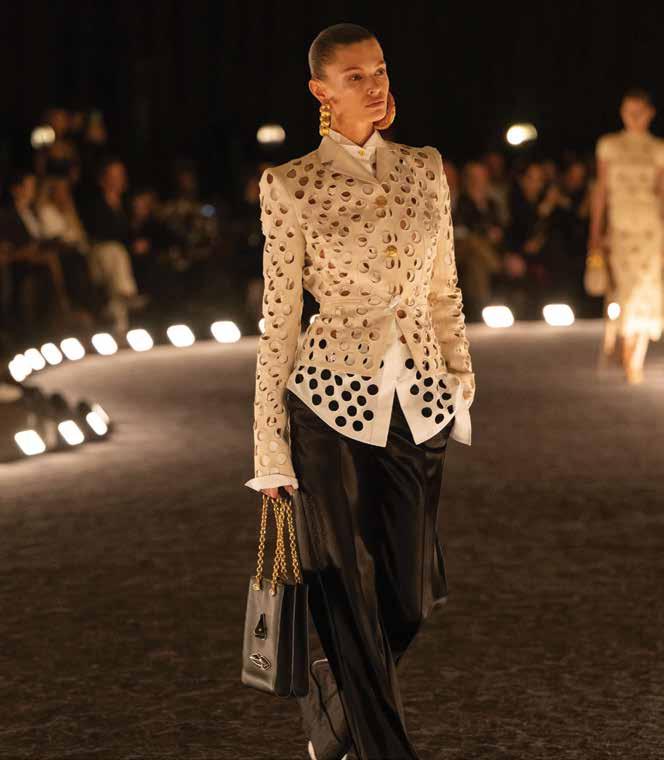
Since taking over the house in 2019, Roseberry has made his seasons a kind of ritual: each collection is anticipated not only for new pieces, but for the ways he challenges the boundaries of what Schiaparelli can be. He threads Elsa’s audacious surrealism through modern constraints—sacrificing neither concept nor craft. While some designers court spectacle for spectacle’s sake, Roseberry uses restraint, tension, and detail to build suspense. Through every season, he deepens the house mythology: the codes—the keyhole, lips, anatomical fragments— are not pastiche, but symbolic waypoints. With SS26, he doubled down on this approach. He played with transparency, architectural distortion, and sculptural ornamentation, managing to feel fresh while anchoring each piece in house heritage. The press had no shortage of praise; ELLE called the show worthy of a “double take,” noting that Roseberry walked “the tightrope between tension and fluidity.”
From lacquered cone hats to nearly invisible black sheers, SS26 was studded with showstoppers. Among the most striking:
Alex Consani’s sheer black gown: An almost-whisper of fabric, flowing loosely around her frame yet weighted by a goldilluminated gemstone string that descended down her back. The contrast of lightness and gravity felt almost balletic.
Kendall Jenner’s daring dress: Minimal coverage, maximal effect—a sheer black ensemble dotted with sculptural “hair-like” polka details layered over a lace thong. It was a provocative marriage of concealment and revelation.
Sculptural accessories and finishes: Clutches embedded with miniature sculpted fingers, belts echoing vertebrae, and trompe-l’œil embroideries that suggested peeling surfaces

and interior anatomies. These pieces weren’t supplemental—they were protagonists.
The color palette remained lean—black, ivory, touches of crimson and metallic accents—yet within that economy, physical drama unfolded. When shocking pink appeared in a structural gown, its impact felt electric.
Unlike seasons of retro revival or overt nostalgia, SS26 felt like a recalibration of the Schiaparelli ethos. Roseberry didn’t lean backward so much as he looked inward—at the architecture of the body, the tension of concealment, and the emotional weight of adornment. The show reaffirmed that for Schiaparelli under his stewardship, every garment is a negotiation between surface and skeleton, spectacle and silence.
By delivering a collection that moves with you— not just in photos but in memory—Roseberry continues to elevate the anticipation surrounding his shows. He has turned Schiaparelli not into a museum piece, but into a living, morphing language. SS26 wasn’t just another fashion moment—it was a manifesto for avant-garde luxury in motion.

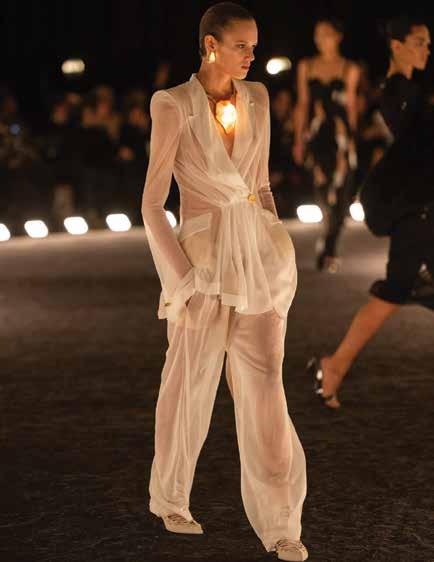
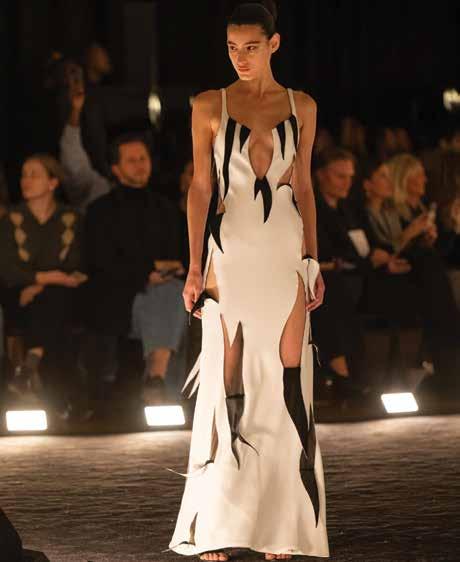



Landing in the People’s Republic of Brooklyn in August to complete work for a film starring your two personal heroes is such a surreal blessing and experience.But this isn’t just any film. And these aren’t just any heroes.
When Academy Award Winners Spike Lee and Denzel Washington join forces, cinema bends. The air changes. New York hums louder. History feels like it’s happening in real time.
Their fifth collaboration, Highest 2 Lowest, marks the long-awaited reunion of two titans who shaped American storytelling — a director who turned the streets of Brooklyn into poetry, and an actor who turned conviction into art. Together, they’ve given us Malcolm X, He Got Game, Mo’ Better Blues, and Inside Man. Now, nearly two decades since they last shared a set, they return to create something altogether different: a towering modern fable about power, faith, and the soundtrack of survival.
Lee’s film reimagines Akira Kurosawa’s 1963 classic High and Low, setting its moral chess match in the pulsing, unpredictable heart of New York’s music industry. It’s part crime thriller, part spiritual odyssey — a film that thunders with the same intensity as the jazz and hip-hop that built the city itself.
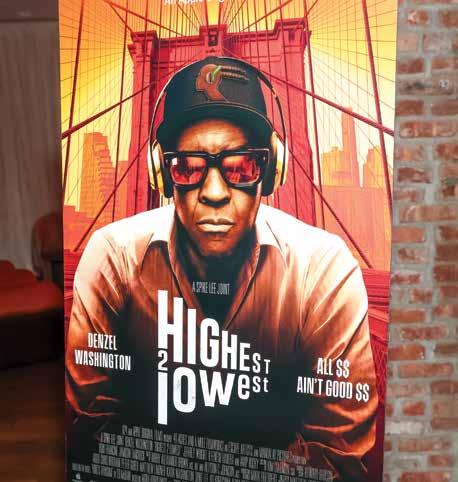
Spike Lee and Denzel Washington join forces, cinema bends. The air changes. New York hums louder.
History feels like it’s happening in real time.
And in the middle of it all stands Denzel Washington, playing David King — a once-untouchable music mogul forced to reckon with the price of his empire and the silence that follows the applause.
Spike Lee calls it “a story about choice.” Washington calls it “a man’s reckoning with God.” What they’ve made together feels less like a movie and more like a modern gospel — one scored to the rhythm of ambition, faith, and the city that never sleeps.
When Denzel Washington first read the script, he knew exactly who had to direct it.
“He is New York City,” Washington said. “He sees it in a way that I don’t even necessarily see it, and I was born and raised here. He’s one of a handful of visionary filmmakers that are unafraid, bold, brilliant. That was the easiest decision I made with this whole project — asking him to get involved.”
Spike Lee remembers that call as a sign.
“I’ve been very fortunate in my film career,” he said. “More often than not, the blessings that I receive are unannounced. I get a phone call or text or email and it starts. I love Kurosawa. I love High and Low. This was an opportunity to work with Denzel Washington and to shoot here in New York.”
This marks their fifth collaboration, following Mo’ Better Blues, Malcolm X, He Got Game, and

Inside Man. But for Lee and Washington, time hasn’t eroded their chemistry — it’s only made it stronger.
“I was shocked when someone told me that the last time we worked [together] was 19 years ago,” Lee said. “It did not seem like that to me or Denzel. We were both surprised it had been that long. There are some people you don’t have to see every day to still have that relationship. This is the fifth film of the dynamic duo. He’s one of the world’s greatest living actors, and I’m very happy we got to work together again.”
Their creative bond remains telepathic — part trust, part challenge. Lee frames the stage; Washington fills it with thunder.
At the center of Highest 2 Lowest stands David King, a once-revered music mogul staring down the twilight of his empire. Played by Washington with equal parts grace and gravity, King is a man wrestling with pride, legacy, and faith.
“I’m a man of God,” Washington said. “I liked the idea of going on this journey of a man who may have considered himself a god in his industry. When we meet him, he’s already been humbled. He’s holding on to what he was, and he’s willing to leverage his home and everything else for a dream that may no longer be his. The music has changed. Everyone can see it but him.”
When King’s driver’s son is kidnapped by mistake, his moral foundation is shaken. Suddenly, the line between wealth and worth blurs.
“Yeah, I’ll do it for mine,” Washington said. “But for someone else? My driver? You find out it’s your best friend’s child — what would you do?”
Lee calls it “a story about choice.”
“It makes the audience think about what they
would do if they were in that situation,” he said. “People are going to react differently.”
The film becomes a mirror — a reflection of ego, empathy, and the ways faith falters under pressure.
For all its high-stakes suspense, Highest 2 Lowest is at its heart a story about love — about family as both burden and blessing.
“It was very important to show a loving, successful African American family,” Lee said. “Denzel felt that way, too. We really wanted to get that across. This is a strong family. They go through it, but it’s that love that keeps them going so that shit doesn’t fall apart.”
Ilfenesh Hadera, who plays Pam King, brings warmth and strength to the role.
“David King is a larger than life figure and maybe not always approachable, even as a father,” she said. “It was important to me to make Pam not just a mother but a friend to Trey. I grew up in a family where my mother was my absolute best friend, and that’s how I wanted Pam to treat Trey.”
Jeffrey Wright, portraying King’s childhood friend and driver, adds emotional depth to the story’s moral tension.
“This fraternal relationship between these two men is bound up in some of these class tensions,” Wright said. “They’ve run the streets together. One ascended and one did not, but they have an allegiance to one another.”
The relationships form the backbone of the film — living proof that, even at the highest levels, survival still comes down to love.
It’s been over a decade since Spike Lee last shot a film entirely in New York, and Highest 2 Lowest marks his return to the city that made him.
“It’s been 10 years since I’ve made a film in New York City,” Lee said. “That’s where I grew up. That’s where I learned my craft. I love this city — the good, the bad, and the ugly.”
And he shows it all. The film moves through the Bronx, Brooklyn, and downtown Manhattan like a musical phrase — each neighborhood with its own rhythm.
Ilfenesh Hadera captures the realism of Lee’s lens.

“He’s up in the Bronx. He’s in Brooklyn. You talk about warts and all — all the beauty of real, historic Brooklyn, the way it used to be, and gentrified Brooklyn now. He’s not trying to glamorize or show New York in a light that it isn’t, and that’s, I think, how any real New Yorker rolls.”
New York is both backdrop and character — unfiltered, unpolished, alive. It’s the city as conscience.
If the city is the film’s body, music is its blood. It moves through every frame — an extension of both David King’s past and Spike Lee’s own legacy.
“I come from a musical family,” Lee said. “My father, Bill Lee, is a great jazz bassist and composer. He did the scores for She’s Gotta Have It, School Daze, Do the Right Thing, Mo’ Better Blues, and Jungle Fever. So, music has always been in my DNA.”
That heritage breathes life into Highest 2 Lowest, a film where the score feels like emotion made audible. Composer Howard Drossin, a longtime Lee collaborator, shaped the film’s orchestral soul.
“Spike wanted a full-blown orchestral score, occasionally interwoven with the intimacy of a jazz trio,” Drossin said. “We recorded with a 90-piece orchestra. The music had to carry emotion, tension, and sometimes even irony — it’s a character in the story.”
And because this is a Spike Lee film, music isn’t confined to the score. The film pulses with the sound of New York — a city always alive with performance and rhythm. In one unforgettable sequence, live performances by the Eddie Palmieri Salsa Orchestra (one of the legendary pianist’s final appearances) erupt into the film’s world, bridging generations of sound. The scene captures the heartbeat of Latin New York — its energy, pride, and poetry — blending seamlessly with the film’s broader spiritual tone. That musical diversity — from orchestral sweep to salsa fever — defines the film’s soul. It’s a work that refuses to separate faith from funk, or gospel from groove.
Then comes A$AP Rocky, who turns in one of the
film’s standout performances as Yung Felon, a young rapper whose ambition mirrors King’s former self.
“Just me being a part of that, it was a dream come true,” Rocky said. “When we were creating Yung Felon’s music, I didn’t want it to sound too much like A$AP Rocky. We wanted it to have its own identity — that New York Bronx energy with something exquisite. We came up with something a little different.”
Lee praised Rocky’s precision and presence.
“He brought it,” Lee said. “He’s got charisma, he’s got the look, and he’s got that star energy you can’t fake. People are going to be surprised by his performance. It’s real. It’s layered. It’s not just swagger — it’s truth.”
Washington echoed that admiration.
“He’s electric,” he said. “He’s got that thing — that presence. You can’t teach it. You just have it. Rocky’s got it.”
The film’s soundscape — from the deep heartbeat of jazz to the roar of hip-hop to the pulse of salsa — bridges generations and cultures, just as Lee and Washington’s collaboration does. It’s a film where music becomes morality, where rhythm becomes redemption.
Highest 2 Lowest isn’t nostalgia. It’s evolution — a film made by two masters who understand that the highest notes of life are always balanced by the lowest chords of loss. It’s a study of success and humility, of wealth and worth, of the music that survives when the lights go out.
Spike Lee has always been a filmmaker of motion and meaning — and here, in his return to New York with his most trusted collaborator, he once again captures a truth that transcends genre.
Because at the end of the day, it isn’t about money or fame. It’s about legacy. It’s about the city that raised you, the sound that shaped you, and the faith that keeps you standing.
And when the credits roll, Lee leaves us with the only words that could possibly close the story: “You know what that is? That’s A Spike Lee Joint.” Special thanks to A24, Apple Films, and the entire cast and crew of Highest 2 Lowest for everything.
the Word “Exclusive”
Xposure Magazine takes you behind the velvet rope at the Highest 2 Lowest premiere party — an exclusive night where every star was in the building, guests immersed themselves in interactive displays and unforgettable experiences, indulged in culinary delights, and celebrated in true NYC style.
We’ve got your all-access pass to the party of the year.
Special thanks to Mr. Lee, A24, Apple TV, and the teams at BAM for the invite!
Event Production & Design: Beyond 8
Florals: Brooklyn Blooms
Catering: Great Performances
The Arrival: A Brooklyn Experience from the Moment You Stepped In
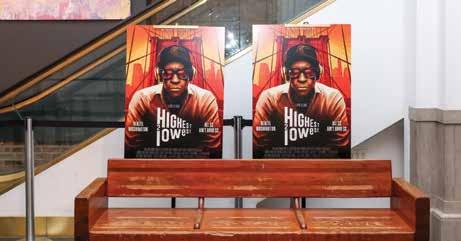



Before guests even reached the escalator to the party, the Brooklyn Academy of Music had been transformed into a living extension of Highest 2 Lowest. The experience began right at the door, where attendees presented a custom Highest 2 Lowest MTA MetroCard — a clever invitation that doubled as an access pass. Swiping in felt like boarding the cinematic subway line of Spike Lee’s imagination.
Once inside, the lobby became an immersive film universe. To the right, a full bodega setup re-created the corner-store culture of Brooklyn — stocked shelves, neon soda coolers, and custom Highest 2 Lowest snack packaging. The scene immediately grounded guests in Spike’s world — a blend of art, nostalgia, and neighborhood realism.
Just beyond the bodega stood the show-stopping Double Dolly Video Booth, Spike Lee’s signature cinematic move turned interactive installation. Guests stepped onto a small platform, gripped a prop mic or film slate, and glided forward in a perfectly timed dolly shot while the movie’s score boomed. Each clip was instantly uploaded with the film’s logo, making every guest the star of their own Spike Lee moment.
Surrounding the booth were mini-sets from the film — a re creation of David King’s recording
studio, a flickering neon street corner, and a rooftop skyline vignette with the city lights shimmering in the background. Before anyone even made it upstairs, they’d already been dropped inside the film’s heartbeat: Brooklyn as both muse and myth.
Up the escalator, the party opened into a dreamlike scene designed by Beyond 8. Projections from the film rippled across walls. Gilded lighting made every glass sparkle. The scent of gardenias and tobacco leaf lingered in the air from Brooklyn Blooms’ lush florals.
like the heartbeat of Brooklyn itself. It wasn’t just a DJ set; it was Spike in his element — commanding the room with presence, pride, and joy.
The bar was a showpiece of its own — a sculptural wood installation glowing under rotating spotlights, serving four signature cocktails inspired by the film:
There were no hierarchies in the room — just community. Rosie Perez and John Turturro, two icons of Spike’s cinematic family, were spotted embracing near the DJ booth as Wendell Pierce traded stories with producers. Across the floor, journalists, stylists, and artists mingled like extended kin.
• The King’s Ransom –Rye, Sweet Vermouth, Angostura bitters
• The Chase –Gin, Lemon Juice, Raspberry Purée
The guest list was a Brooklyn love letter: John David Washington, Spike Lee, Rick Fox, Giancarlo Esposito, Rosie Perez, John Turturro, Wendell Pierce, A$AP Rocky, Ice Spice, and Dapper Dan all in attendance — icons and newcomers alike mingling in a room that felt equal parts film set and neighborhood block party. The vibe? Elevated but unpretentious. Laughter, hugs, and the hum of shared creative energy carried through every corner of the space.

• Sula’s SongWatermelon, Cucumber, Club Soda
The drinks became the social currency of the night — raised, clinked, and toasted again and again.
By the time the clock struck midnight, the energy was still swelling. Spike returned to the booth, smiled wide, and dropped one last track — a remix of the film’s score mixed with crowd cheers recorded earlier that night. The dance floor surged. Champagne flowed.
Just when the energy couldn’t rise higher, Spike Lee stepped behind the DJ booth. His entrance sparked cheers as camera flashes exploded like fireworks. He grinned, queued a record, and let the bass drop.
What followed was pure celebration — movement, rhythm, and energy that pulsed through the room
As the lights dimmed and guests began to trickle toward the exit, they paused downstairs at the Double Dolly Video Booth one more time, filming a final glide through Spike’s cinematic lens. The bodega lights flickered, the MetroCard scanners beeped, and outside, the Brooklyn night felt charged with something bigger than a premiere — it felt like legacy.
This wasn’t just an afterparty. It was a statement of culture, creativity, and community.
It was Brooklyn — alive, fearless, and in motion.
Special thanks to Mr. Lee, A24, Apple TV, The Belmont Agency, Beyond 8, Brooklyn Blooms, Great Performances, and the team at BAM for the invite!
This was more than a celebration.
This was a Spike Lee Joint — in real life.
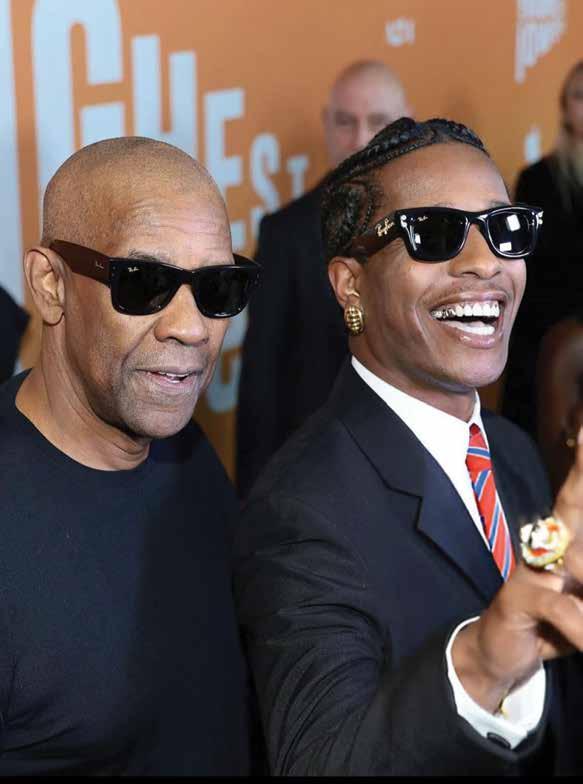



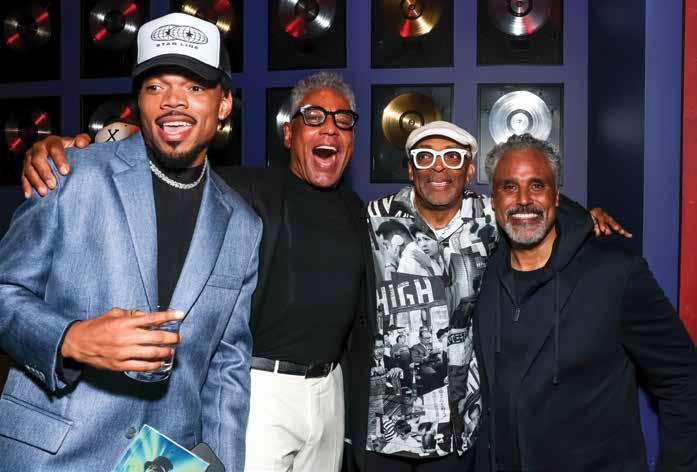

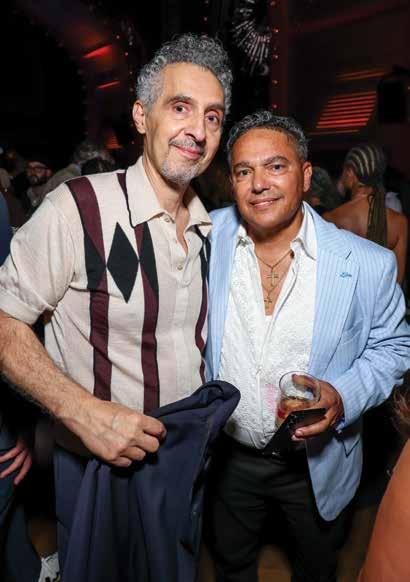





Carbone—the iconic New York–born Italian-American institution—is setting its sights on London. This highly anticipated arrival marks the brand’s European debut and a dazzling addition to the city’s culinary scene.
Founded in 2013 by Mario Carbone, Rich Torrisi, and Jeff Zalaznick under Major Food Group, Carbone quickly became legendary for its mid-century décor, Rat Pack–style playlists, and theatrical service—complete with tuxedoed servers, “breadbasket moves,” and tableside flourishes.
Carbone London takes residence at 30 Grosvenor Square, within the historically esteemed Grade II-listed former US Embassy building—now transformed into The Chancery Rosewood hotel. The façade, reimagined under Sir David Chipperfield’s restoration, now houses a sophisticated, sprawling restaurant with a ground-floor terrace, bar/lounge, and a glamorous basement main dining room. Its debut coincides with the hotel’s September 2025 opening schedule.
True to its heritage, Carbone London revives the mid-century charm with signature elements—burgundy fabrics, mosaic floors, and satin-panelled walls— augmented by bespoke artwork curated by Vito Schnabel. Expect bold pieces from Ai Weiwei, David Salle, Rita Ackermann, and a monumental Julian Schnabel canvas filling an entire wall.
Carbone London preserves beloved menu staples— spicy rigatoni vodka, veal marsala, Caesar alla ZZ, bass Alison, and classics like lemon cheesecake and
carrot cake. Simultaneously, it introduces new local expressions: standout dishes such as scallops rosmarino featuring Scottish diver scallops with pork lardo and preserved orange peel, alongside an elevated custard-based tiramisu replacing the old cake version.
Carbone’s signature style extends beyond the dishes— the “service moves” remain front and center. Diners are greeted with generous breadbaskets, meat, cheese, and pickles before menus even land. Expect tableside theatrics with dishes like Dover sole piccata and flambé desserts, all delivered by charismatic “Captains” in costume. As Mario Carbone puts it, “This is a play, not a restaurant… every night, the same performance, with the same jokes for a different audience”.
Co-founders Jeff Zalaznick and Mario Carbone have long dreamt of bringing Carbone to London. They deliberately waited until finding the perfect Mayfair location—“no more than ten minutes’ walk from Claridge’s”—to ensure the right neighborhood alignment with their high-end Italian American concept (priced at over £100 per person)
Carbone expresses a nostalgic affection for London: “There’s something very nostalgic about this city… I’ve never seen anything remotely similar to what we grew up with here.” Expect nothing less than their best Carbone yet. Carbone’s launch in London this September is a momentous event in the restaurant world. It skillfully marries beloved Italian-American legacy with fresh, locally inspired nuances, all housed in a location fused with historical gravitas. With its immersive design, playful service, and culinary excellence, Carbone London promises to deliver an unforgettable dining spectacle—one fit for both locals and jet-setting fans of this celebrated brand.
New York, meet your chic new sip scene.* Kith is bringing Erewhon’s famed wellness elixirs east—but with a VIP twist. The legendary Los Angeles–based grocer known for its celebrity-coveted $20-plus smoothies is launching a compact “tonic bar” inside Kith’s upcoming private padel and wellness club, Kith Ivy, slated to open in Manhattan’s West Village later this year.
While an exact launch date hasn’t been announced, sources confirm the venue at 120 Leroy Street, West Village, is under development and expected to open before year-end. The “mini-Erewhon” will operate as a juice and smoothie kiosk—functioning more like a specialty tonic bar than a full grocery outpost—and will be open daily from 7 a.m. to 4 p.m. for members.
This partnership represents a meaningful leap for both:
This marks Kith’s first foray beyond fashion and apparel into high-end lifestyle hospitality. As Highsnobiety aptly put it, “The Kith Ivy club in New York is our most holistic entry into hospitality, expanding outside of dining into true lifestyle services, sport and wellness, and product,” said Ronnie Fieg, founder of Kith. By injecting Erewhon’s wellness prestige into its club, Kith leverages cultural cachet to elevate its brand ecosystem—and solidify its reach into experiential luxury.
For Erewhon, this is the storied brand’s first East Coast presence. The “tonic bar” allows Erewhon to test New York demand, elevate its mystique, and create buzz without fully committing to brick-and-mortar expansion. It’s a highly curated entry that respects the brand’s symbol of exclusive, wellness-obsessed cool.
For the city’s trendsetters, this collaboration is thrilling—an elite wellness destination tucked inside a glitzy sports and lifestyle club. Delish captured the excitement: fans were already clamoring, writing things like, “Erewhon in NYC omg,” “Might move back to NYC just for this…,” and “Erewhon and a Hammam count me in.” Even Justin Timberlake and Gigi Hadid reportedly chimed in with emojis and enthusiastic reactions.
But the project isn’t without controversy. West Village residents have vocally opposed aspects of Kith Ivy, especially earlier plans for a rooftop bar and DJ events, citing concerns about noise, traffic, and neighborhood character. Though rooftop elements were scrapped, tensions linger—and many locals view this elite enclave as out of step with the community’s texture.
Membership to Kith Ivy—and by extension Erewhon—won’t come cheap. Media reports put the initiation fee at $36,000, plus $7,000 in annual dues, bringing the first-year cost to around $43,000. That fee grants physical access to the padel courts, spa amenities, and Erewhon’s juice bar from 7 a.m. to 4 p.m.
But the rest of New York need not feel left out: Erewhon has partnered with Postmates and Uber Eats to deliver smoothies to nonmembers within a certain radius —so the smoothies may be elite, but delivery remains democratic.
Kith’s bold invitation to Erewhon is more than a brand cameo—it’s a cultural statement. For Kith, it’s hospitality on steroids; for Erewhon, it’s icon expansion with cachet. And for New York, it may be the ultimate blend of luxe exclusivity and ubiquitous access… for those willing to pay for the privilege— or just tap “order now.”





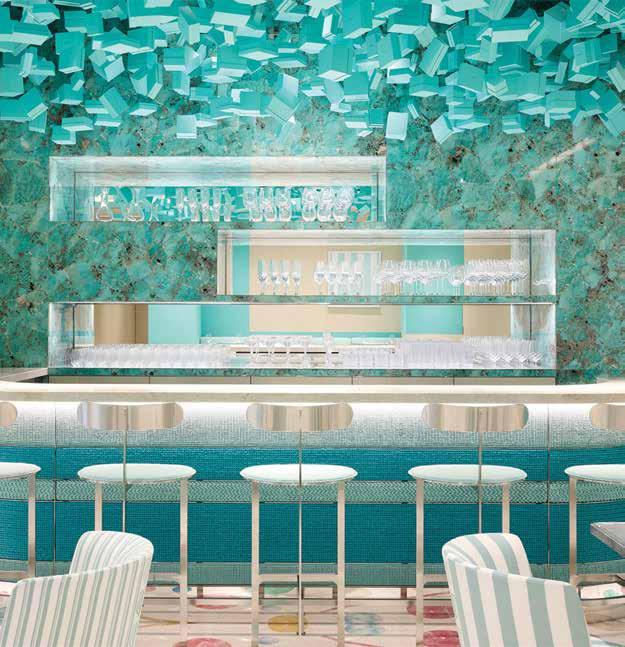




On August 8, 2025, Tiffany & Co. unveiled its first-ever Blue Box Café in Japan, perched on the fourth floor of the newly opened Tiffany Ginza flagship in Tokyo’s upscale shopping district. Helmed by award-winning chef Natsuko Shoji—named Asia’s Best Female Chef in 2022—this café is a serene fusion of Tiffany heritage with refined Japanese patisserie artistry.
Designed by renowned architect Peter Marino, the space is a striking canvas of Tiffany Blue elegance, featuring a sleek dining room, bar, private dining area, and a terrace offering views over Ginza. Artistic touches elevate the experience further—from a floral installation by Azuma Makoto to contemporary artworks by Molly Hatch, Johan Creten, Sarah Charlesworth, and Roe Ethridge.
seasonal Japanese ingredients with New York flair. Breakfast at Tiffany’s includes a delicate dashi-infused scrambled egg, artisanal brioche, a seaweed-tinged soup, house-made maple granola with vanilla yogurt, and salmon with sudachi and lemon—elevating humble breakfast items with elegance.
cherry trout and avocado tarts, and floral mortadella-egg creations with scones.
The All-Day Menu features visually stunning and taste-rich dishes such as wagyu tartare, thoughtfully plated salty and savory mains, seasonal fish, and the standout “Cheesecake 727”, a nod to Tiffany’s Fifth Avenue flagship address. The drinks menu marries classic cocktails with Japanese spirits.

Chef Shoji has thoughtfully curated three distinct culinary experiences—Breakfast at Tiffany’s, Tiffany Afternoon Tea, and an All-Day À La Carte Menu—each blending
Tiffany Afternoon Tea is served on a classic three-tier stand. The top tier presents a seasonal fruit tart; the middle offers Tiffany Blue® macarons, vanilla cheesecake, financiers, and praline ganache; and the bottom delivers savory bites—jewelry-inspired cucumber sandwiches, mushroom and crab layers, caprese in tomato form,
This café stands as more than a place to dine—it’s a crafted experience, bridging Tiffany’s legacy with Shoji’s culinary finesse and Tokyo’s seasonal rhythms. Reservations open on the first of each month for the following two months and are managed exclusively via Tiffany’s official website.
The Blue Box Café by Natsuko Shoji is a sensorial treasure— where Tiffany Blue envelops the senses, Japanese refinement meets New York glamour, and every dish and design element tells a story. Whether you’re an aesthetic enthusiast, food connoisseur, or admirer of artistic luxury, this café offers a dining experience as beautiful as it is flavorful.
In an unexpected and somewhat controversial move, Emirates has amended its Skywards terms and conditions to prohibit children aged 8 and under from booking or upgrading to first class when using Skywards miles. This change, which quietly took effect on August 15, 2025, applies solely to award redemptions and upgrade rewards—not to cash fare bookings. Children remain welcome in first class if their ticket is purchased outright with money.
The exact policy wording reads:
“Passengers aged 8 years old and below are ineligible for First Class Emirates Classic Rewards and Upgrade Rewards.”
Families often rely on miles to afford premium travel, making this newly imposed barrier feel particularly exclusionary. Travelers on forums and blogs argue it introduces an unfair divide: children traveling on cash tickets can enjoy first class, while those flying with miles cannot.
Critics highlight the irony given the significant costs of first class awards—often approaching 200,000 Skywards miles plus hefty surcharges. In many cases, families are paying nearly as much—if not more—than full-fare customers. Additionally, the booking system still appears to allow award bookings for under-8s, suggesting enforcement may not yet be fully in place.
Supporters of the change say children—even well-behaved ones—can disrupt the premium experience first class is meant to provide. The policy, they argue, is an understandable move to preserve tranquility in the cabin for travelers willing to pay cash.
Emirates is one of the first global carriers to enact age-based restrictions tied specifically to award

access rather than blanket bans. This unprecedented approach could become a blueprint for other airlines aiming to control premium cabin occupancy by revenue versus loyalty spend.
The move may signal a growing trend among airlines to manage loyalty benefits more tightly— prioritizing profitability and brand positioning over loyalty perks. If Emirates successfully maintains first-class exclusivity without significant backlash, others might follow suit.

For now, families planning to travel in first class on miles need to rethink their strategy—either book cash fares for children or delay elite redemptions. As booking systems continue to allow under-8 awards, there’s ambiguity about how Emirates will handle such cases at the gate.
Absent any public statement from Emirates, questions remain: Is this policy rooted in brand preservation, loyalty economics, or passenger comfort—or a combination thereof? And how strictly will it be enforced?
One thing is clear: by introducing selective access based on payment method, Emirates has opened a fresh new chapter in the debate over premium travel perks, equity, and exclusivity. Whether this marks a broader industry shift—or remains an isolated experiment—remains to be seen.
In December 2025, Sotheby’s will make a landmark move— landing in Abu Dhabi with its first dedicated luxury auction series in the UAE capital, the aptly named Abu Dhabi Collectors’ Week. This marks not just a geographic expansion, but a strategic pivot into the Gulf’s booming art and luxury economy.

recent years—this physical presence translates to access, prestige, and influence locally.
Josh Pullan, Global Head of Sotheby’s Luxury Division, frames the move as a connective moment:
“We believe it’s the perfect moment to bring local and international collectors together to experience Abu Dhabi.”
• Dates & Venue: Abu Dhabi Collectors’ Week will run December 2–5, 2025, staged at the St. Regis Saadiyat Island Resort.
• Preview Exhibition: Ahead of the auctions, Sotheby’s will host a high-profile, museum-level preview at the Bassam Freiha Art Foundation in Saadiyat’s cultural district during October 1–2. Works by masters like Magritte, Munch, Van Gogh, Gauguin, Frida Kahlo, and Pissarro will be shown.
• Auction Slate & Highlights: The sales will span multiple categories—fine art, jewelry & watches, collector cars, real estate, and luxury objects. Among the standout names: a giant pink diamond, a rare vintage Rolex, and McLaren race cars (including a future F1 car) will cross the block.
This debut isn’t just symbolic; it’s tactical. Abu Dhabi is aggressively positioning itself as a cultural and luxury hub, with heavy investments in global museums, art districts, and cultural institutions (Louvre Abu Dhabi being a shining precedent).
Sotheby’s move is also backed by financial alignment: last year, Abu Dhabi’s sovereign wealth fund ADQ took a minority stake in Sotheby’s (a $1 billion infusion), signaling deep mutual interest in bridging Gulf capital and the international art market.
As Sotheby’s CEO Charles Stewart noted in past comments, the ADQ investment is meant to reduce leverage and fuel growth initiatives.
With Gulf buyers already showing rising appetite— UAE-based collectors’ purchasing has climbed in
From the official Sotheby’s press release:
“As Sotheby’s extends its presence and activities in the Middle East, this exciting exhibition underscores our commitment to bringing masterpiece works of art to the region.”
These remarks underscore a broader aspiration— Sotheby’s is not just “visiting” the region but embedding itself there, turning auctions into cultural landmarks.
• Hybrid Exhibition–Auction Model: Expect seamless transitions between museum-style previews (Abu Dhabi, then London, Paris) culminating in the core auctions in New York, but with local legs in the UAE.
• Rising Market Integration: Gulf collectors may get enhanced access (VIP viewings, pre-bid privileges) and Sotheby’s may develop a more permanent footprint—offices, exhibition spaces, even satellite galleries.
• A Cultural Shift in the Gulf: This helps codify the UAE not just as a buyer’s market but as a node in the global supply chain of art. Local and regional artists, too, could benefit from new visibility and infrastructure.
• Competitive Ripples: Christie’s and other houses are likely to respond—or accelerate their own Gulf strategies—to maintain parity in influence and collector access.
Barbuda, once known primarily as the quiet counterpart to Antigua, is poised to shine as a premier luxury destination—thanks in large part to the upcoming Nobu Beach Inn. This highly anticipated resort, backed by Robert De Niro, Nobu co-founder Nobu Matsuhisa, Meir Teper, James Packer, and developer Daniel Shamoon, is currently under active development and slated to debut in 2026.
Located along over 400 acres of southwest Barbuda coastline and stretching across two miles of secluded beach—once a hideaway for Princess Diana—the resort embodies “barefoot luxury” and sustainable design. Architectural plans include 36 guest rooms
housed in 17 bungalow-style cottages, designed to blend seamlessly into the island’s lush landscape.
Complementing these guest accommodations are 25 private beachfront villas available for purchase—each starting at approximately $12 million. These villas are intended as personal sanctuaries, comprising interconnected bungalows with private pools and gardens, fully customizable and serviced through the Nobu rental program.
The Nobu Beach Inn promises more than just upscale lodging—it pioneers community-minded luxury. Public spaces will include
a Nobu restaurant and omakase sushi bar, outdoor lounge areas, a spa, oceanfront pool, film pavilion, and courts for tennis, padel, and pickleball. Guests can enjoy curated experiences such as sunset DJ sets, chef-led pop-up dinners, and a rich schedule of wellness offerings.
Environmental stewardship remains central. The resort will operate off-grid using a combination of LNG, solar photovoltaic arrays, and battery storage. Water will be sourced via on-site reverse-osmosis wells, with greywater recycled for irrigation. A Bionest sewage system, rainwater capture, and a working organic farm feeding into resort dining and homeowners further underscore the project’s eco-conscious ethos.



The project aims to foster local empowerment—prioritizing employment for Barbudans and showcasing local talent in agriculture, design, and arts. A philanthropic fund, supported by homeowner dues and guest contributions, will be established to support education, entrepreneurship, and other community-focused initiatives.
Construction is underway, with Nobu’s official site confirming the opening is set for November 2026. Pre-sales for the villas are expected to begin in late 2025.


The resort’s emergence coincides with wider developments on the island. A new international airport has recently opened—facilitating access by private jets and charters, making Barbuda more accessible while preserving its intimate ambiance.
Despite the promise of transformation, not all reception has been positive. The resort has sparked controversy due to land ownership issues and fears over environmental and cultural erosion. Barbuda’s communal land system, enshrined in the Barbuda Land Act of 2007, has historically barred private ownership. In 2015, the
Antigua government passed the “Paradise Found Act” to lease land to De Niro’s development company for 99 years—prompting backlash from residents and activists concerned about land rights and environmental impact. By 2026, the Nobu Beach Inn is set to redefine Caribbean luxury with its low-density, eco-conscious design, deep ties to community, and seamless integration into Barbuda’s pristine landscape. Yet, the project unfolds amid important conversations about local autonomy and environmental safeguarding. As plans progress, the world watches how Nobu will balance its ambition with respect for an island’s soul.
The W New York – Union Square has officially reopened after an impressive $100 million renovation, marking its evolution into the brand’s global flagship and reaffirming its cultural importance in New York City’s luxury lifestyle scene.
The Rockwell Group—who originally designed the hotel in 2001—led the renovation under the vision of David Rockwell. Drawing heavily from the textures, hues, and ever-changing spirit of Union Square Park, the redesign evokes nature’s shifting seasons through interior motifs.
• Grand Staircase & Lobby Entrance: A signature lava-like, abstract carpet cascades down a curvilinear staircase—an arresting first impression. Houndstooth banquette welcome desks, marble flooring, and a mural by Shantell Martin lend artistry and grandeur at the entrance.
• The Living Room (Lobby): Once a ballroom, this space now features soaring ceilings, original marble columns, and carved rosettes. The color palette of greens and blues is complemented by serpentine velvet seating, petal-inspired chandeliers, and a double-height bar embedded with botanicals cast in resin—a dramatic nod to Art Deco influences.
• Guestrooms: Interiors are rich with botanical carpeting, curved lacquered wall panels, ombre


wallpaper, burnt-orange velvet headboards, tufted green sofas, and circular bronze tables—all inspired by park elements.
• Public & Wellness Spaces: The hotel introduces Union Square’s first rooftop bar, designed by AvroKO, featuring both indoor and open-air seating with sweeping skyline views. The subterranean bar has been transformed into the FIT wellness space, equipped with a Peloton studio, hydromassage chairs, and a recovery zone.
• Seahorse Brasserie: A new sea-focused brasserie by John McDonald and Mercer Street Hospitality brings bold, creative seafood and cocktail offerings to the hotel’s dining lineup.
• Living Room Café: This multifunctional space serves as a coffee bar by day and transforms into a cocktail lounge at night—a first for the W brand and a vibrant draw for locals and travelers alike.
• Event Spaces: The hotel’s 2,587 square feet of meeting space now features Herman Miller furnishings, custom carpets, and rich textures, bringing an elevated, thoughtful design to its function rooms.
George Fleck, W Hotels SVP and Global Brand Leader, emphasizes the significance of the site:
“W New York – Union Square holds a special place in our global portfolio… not as a replica of what it was, but as a bold expression of what’s next.”
Christina Poon, General Manager of W New York – Union Square, celebrates the emotional and local resonance:
“This reinvention is about more than design… creating moments that resonate with every guest… a place where locals and travelers alike can gather, connect, and experience the heart of the city in a way only W Hotels can deliver.”
Visitors will step into not just a hotel, but a cultural destination:
• Start the Day in the Living Room Café, sipping coffee in a richly appointed space rooted in history.
• Dine at Seahorse, indulging in inventive seafood dishes in a stylish, refined setting.
• Unwind at the Rooftop Bar, enjoying sweeping views and dynamic social energy above Union Square.
• Recharge Body & Mind in the FIT studio—ideal for wellness-minded guests seeking active recovery.
• Stay in Stunning Guestrooms that blur the line between park scenery and urban luxury.
• Host or Attend Events surrounded by designer furnishings and textured elegance in meeting spaces that feel anything but ordinary.
The renovation of W New York – Union Square is more than a facelift—it’s a cultural reawakening. With deep design, neighborhood connection, and heightened amenities, the hotel now stands as a beacon for W Hotels’ renewed identity—energized, emotionally resonant, and unmistakably of New York.

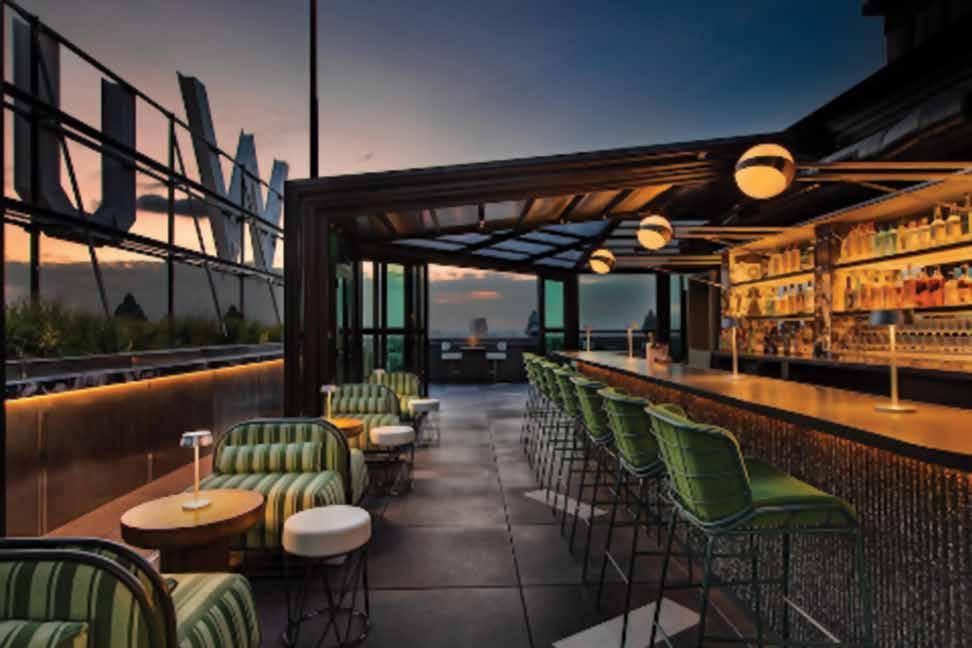
In the realm of ultra-luxury Sedans, the Maybach S 680 V12 Edition stands not merely as a statement, but as an exclamation — a bold proclamation that power and refinement need not be at odds. This is the car for those who demand every journey be an experience, an affirmation that true luxury lies in the synthesis of artistry, engineering, and presence.
Under the long, sculpted bonnet of the Maybach S 680 lies a handcrafted 6.0-litre twin-turbo V12 engine. This masterpiece delivers 621 horsepower and 664 lb-ft of torque, a formidable output that sends the sedan from standstill to 60 mph in roughly 3.9 to 4.2 seconds, depending on conditions.
This V12 isn’t just about brute force; it is engineered for serenity. The torque curve unfolds with smooth precision, effortlessly propelling the car forward even under the most demanding load. Gear changes via the 9G-TRONIC ninespeed automatic transmission are seamless, whisper-quiet affairs. Driving dynamics are enhanced by 4MATIC all-wheel drive, distributing power intelligently to all four wheels, and by active suspension systems that adapt to road conditions instantaneously. The combination ensures that whether cruising a highway or navigating winding back roads, stability, control and composure remain uncompromised.
From every angle, the Maybach S 680 V12 Edition commands attention. Its elongated body—
measuring over 215 inches in length—gives it a stately silhouette. The signature Maybach grille, bold chrome accents, exclusive V12 badging, and bespoke two-tone MANUFAKTUR paint options elevate its visual impact.
Attention to aerodynamic detail is subtle but significant: rear-wheel steering, integrated rear diffusers, and aerodynamic airflow channels help maintain poise at speed and reduce drag. Along the flanks, sculpted lines and precise panel work catch the light just so, offering visual drama without ostentation.

Step through the soft-close doors, and the Maybach S 680’s cabin reveals its greatest strengths. Silk-soft Nappa leather, warmed ebony woods, and hand-finished metal trim combine to produce a cocoon that feels both sumptuous and technically advanced. Rear passengers enjoy executive-level treatments: reclining seats, lumbar and massage functions, climate zones, and integrated screens for entertainment. A Burmester® 4D audio system envelops the cabin in rich sound, tailored to reflect the acoustics of this particular environment. Ambient lighting with dozens of customizable hues allows each occupant to create their preferred atmosphere.
To maintain tranquility, active noise cancellation, acoustic glazing, and meticulous insulation are standard — even when cruising at speed, cabin noise is held to remarkably low levels.
The S 680 V12 Edition seamlessly blends analog artistry with state-
of-the-art technology. The MBUX multimedia system responds to voice, gesture, and touch; augmented-reality navigation overlays real-world camera views for more intuitive guidance. Rearseat passengers control their own climate, media, and comfort settings via their interface modules. Driver-assistance features abound: adaptive cruise with steering assist, lane-keeping, blind-spot monitoring, 360° cameras, and predictive safety systems ensure not just luxury—but security. The car’s chassis electronics react in microseconds to changes, anticipating body roll or pitch and adjusting damping in real time.
The Maybach S 680 V12 Edition is not a sedan that sings; it is a sedan that orchestrates. It embodies a rare combination: ferocious performance disguised beneath a veneer of graceful elegance, hyper-luxury that feels natural rather than forced, and advanced systems that serve, rather than command. It is a choice for those who wish for more than mere transport — a choice for those who demand their conveyance be worthy of their vision. This is the car that declares: luxury is not in what you see, but in what you feel; power is not in how loudly it roars, but how silently it yields— yet always obeys. The Maybach S 680 V12 Edition stands as an apex in a world of ambitions.







The Range Rover Sport SV redefines the concept of a luxury performance SUV, blending brute force with elegance and cutting-edge technology. This model, introduced as a successor to the SVR, brings a refined yet potent presence to the Range Rover Sport lineup—a triumph of modern engineering that doesn’t announce its arrival with flamboyance, but with undeniable authority.
At the heart of the SV lies a potent 4.4-liter twinturbocharged V8 mild hybrid engine, borrowed from the BMW M5, delivering 626 horsepower and 553 lb-ft of torque. This power, channeled through an eight-speed automatic and all-wheel drive, propels the hefty SUV from 0 to 60 mph in just 3.6 seconds and onto a top speed of 180 mph.
Yet the SV’s excellence lies not only in its straight-line speed but how it connects to the road. Its 6D Dynamics air suspension—an innovative system combining dynamic air springs, hydraulic dampers, and rear-wheel steering—significantly reduces pitch and roll, delivering poised handling even at high velocities. In reviews across racetracks, journalists noted how composed and agile it felt, rivaling supercars despite its size and weight.
Inside, the SV shines with luxury. The Edition One version, exclusive and invitation-only, included plush leather seats with heating, cooling, and massage functions, alongside a groundbreaking “four-dimensional” sound system capable of haptic vibrations that enrich the audio experience.
Originally released in limited runs—Edition One and Edition Two—the SV has since been integrated into the standard Range Rover Sport lineup. Pricing begins at approximately £139,995 for the regular SV, while the more dramatic SV Black variant is priced around £154,975, with the Carbon edition topping out near £165,045.

The SV Black edition elevates darkness to an art form: its exterior and interior are cloaked entirely in gloss black, from carbon-fiber bonnet and forged 23-inch wheels to quad exhausts. Even badges and interior trim embrace the noir aesthetic, offering a moody and commanding presence. Most recently, the SV Carbon, premiering at Monterey Car Week, adds a lightweight performance twist. It features carbon finishes, exposed carbon bonnet, and bespoke color palettes that enhance both style and performance.
Braking performance is equally impressive, thanks to carbon ceramic brakes and eight-piston SV calipers that offer exceptional stopping power under demanding conditions.

The Range Rover Sport SV is a masterclass in blending power, poise, and panache. Its formidable V8 powertrain, sophisticated suspension and braking, thoughtful luxury, and layered special editions make it a standout in the luxury SUV segment. Whether in standard, Black, or Carbon form, the SV offers a commanding and emotionally resonant driving experience that few rivals can match.



Porsche’s all-electric Macan hits model year 2026 with smart, usability-first upgrades that make daily life easier without diluting the brand’s driver-centric character. The headline changes: beefed-up towing, phone-as-key convenience, new parking and reversing assists, and a richer infotainment experience—while the core PPE underpinnings (800-volt architecture, rapid DC charging, and dual-motor performance) remain intact. U.S. deliveries begin in spring 2026, and orders are open now.
The Macan Electric line continues with dual-motor all-wheel drive and an approximately 100-kWh battery (gross) on an 800-volt system that supports up to ~270 kW DC fast charging. In ideal conditions, that enables very short 10–80% sessions—one of the quickest in the class. EPA estimates for the current setup carry over, with ~315 miles for the longest-range configuration and 308–288 miles depending on trim and wheels. Expect the 4 to favor range and the Turbo to prioritize outright thrust.
Porsche’s updates target everyday usefulness. Maximum towing climbs to 5,500 lb (an increase of 1,100 lb on AWD variants), expanding the Macan Electric’s adventure credentials. A Digital Key lets you lock, unlock, and start the SUV using your smartphone or smartwatch—no fob required. The optional 3D Surround View with Active Parking Support gains

a clever Reversing Assist that can retrace recent maneuvers to ease you out of tight spots. Porsche also sprinkles in infotainment enhancements, including AI-assisted voice functions and in-car gaming to help pass time while charging.

Trim-specific outputs span from roughly 402 hp in the Macan 4 to well over 600 hp in the Turbo, delivering the instant, elastic thrust EV buyers expect with the steering feel and chassis polish Porsche loyalists demand. Early tests underscore the Macan Electric’s blend of composure and punch, noting that even non-Turbo models feel authentically Porsche in the way they carve a back road—quietly.
Inside, the Macan Electric pairs crisp displays with tactile controls and the latest Porsche Communication Management software. Expect a concave digital instrument cluster, a high-resolution center screen with a dedicated app hub, and a passenger display in higher trims. The charging planner is smarter for 2026, and
the driver-assist suite grows more capable without becoming intrusive. As before, rear-seat and cargo room are adequate rather than cavernous—more “sporty crossover” than “family hauler.”
For the U.S., Porsche lists the Macan Electric lineup from around $78,000 (Macan Electric) and $81,600 (Macan 4 Electric), with the Turbo cresting six figures; thirdparty guides peg the 2026 base at about $80,350 as equipment shuffles. As ever with Porsche, options can move the needle quickly. First customer cars land spring 2026.
The 2026 refresh doesn’t chase headline power bumps; it makes the Macan Electric easier to live with—tow more, park smarter, carry your “key” on your phone—and keeps it competitive as Porsche winds down combustion Macan production globally. If you wanted a compact luxury EV that still feels like a Porsche, this modelyear update simply broadens the reasons to say yes.

One of the most consequential announcements in the Cadillac F1 saga is its collaboration with Ferrari. In December 2024, Ferrari publicly confirmed that it would supply Cadillac with both its power unit and gearbox beginning in the 2026 season. This opens the door for Cadillac to field a competitive car from the get-go, without needing to build a fully functioning F1 engine program immediately. This arrangement is already understood to be multi-year. Reports suggest the deal could extend through 2028, giving Cadillac breathing room. Meanwhile, Cadillac’s broader plan is to build its own F1 power unit infrastructure under GM Performance Power Units (GM PPU), with a target of becoming more independent by 2029. Until then, the Ferrari link serves as a technical bridge.
It’s worth noting that having a “customer relationship” with Ferrari isn’t unprecedented in F1, but the optics are interesting: Cadillac, an American brand, will initially race with Italian power — at least until its own engine program comes online. Ford, which will also enter F1 in 2026, has already taken jabs at this alliance, pointing out the irony of “Cadillac with Ferrari engines.”

In August 2025, Cadillac confirmed that Sergio Pérez and Valtteri Bottas will comprise its inaugural driver pairing for the 2026 season. Both are race winners with long F1 pedigrees. Pérez, recently released by Red Bull, brings championship experience; Bottas offers consistency and development insight. With this duo, Cadillac emphasizes starting with known quantities rather than betting entirely on rookies.

of a Ferrari model (e.g. SF-23).
Beyond the main lineup, Colton Herta, a prominent American in open-wheel racing, has been named test driver for Cadillac. Herta’s role gives him a pathway into F1 exposure, though he currently lacks the full superlicense points to race immediately. Herta’s inclusion also helps signal Cadillac’s ambition to have an American development pipeline.
Cadillac is slated to make its Formula 1 entrance in the 2026 season, officially becoming the sport’s 11th constructor. The team has already secured final approvals from FIA and Formula 1, meaning the regulatory path is cleared. The 2026 season coincides with sweeping regulation changes in F1 (new power unit rules, aerodynamic shifts), offering Cadillac a chance to start fresh rather than retrofit old architectures.
Early in its development phase, Cadillac is expected to commence on-track testing using a Ferrari chassis or modified Ferrari car, under the customer-supplier pipeline, before its own car is fully matured. Sergio Pérez himself has confirmed plans to drive an F1 car during development (simulator work in Charlotte followed by sessions in England). Some media already suggest Cadillac’s first laps in testing may be conducted in an adaptation
The debut circuit will likely be the Australian Grand Prix (as the first race of the 2026 season), consistent with F1’s traditional opening.
• Engine autonomy timeline: While the Ferrari tie gives Cadillac shortterm stability, the success of its in-house engine program (slated for 2029) will be key to long-term competitiveness.
• Contract length with Ferrari: There’s speculation the Ferrari supply deal might run 2026–2028, but the exact terms and exit flexibility remain opaque.
• Performance expectations: Starting as a new team is usually a slow climb. Cadillac will need to leverage design excellence, simulation/data development, and the experience of Pérez and Bottas to avoid being backmarker fodder.
• Investor & partner signals: Cadillac has also announced non-technical partnerships (e.g. Jim Beam as a spirits sponsor) to strengthen its brand presence in the F1 ecosystem.
• American identity: With some operations in Indiana, North Carolina, Michigan, and Silverstone, Cadillac is balancing U.S. roots with European racing infrastructure.

The 136-meter Flying Fox, built by our friends at Lürssen, is more than a yacht—it’s a legend. With her recent $400 million off-market sale to a UAE-based owner, this floating palace enters a new chapter in her story. To understand why this transaction is so momentous, it’s worth tracing the vessel’s journey from groundbreaking launch to global icon.
Launched from the famed Lürssen shipyard in Germany, Flying Fox instantly redefined what a superyacht could be. At 136 meters (446 feet) long, with a 22.5-meter beam and nearly 9,000 GT of interior space, she ranked among the world’s largest yachts. Her exterior, drawn by Espen Øino, balanced sleek lines with imposing volume, while Mark Berryman’s interior design delivered understated elegance.
Highlights included:
• A 12-meter swimming pool spanning the aft deck.
• A two-deck spa with cryotherapy chamber, hammam, and wellness suites.
• Twin helipads to receive full-size helicopters.
• A submarine garage and professional dive center with decompression chamber.
• A private cinema and lavish guest suites.
From day one, Flying Fox was less a yacht than a floating resort. 2019–2021: The Charter Queen Flying Fox quickly became the
most expensive charter yacht in the world, commanding fees exceeding $4 million per week. Celebrities, tech moguls, and royalty were spotted aboard. She became shorthand for ultimate indulgence— gracing glossy magazines, whispered about in pop culture, and symbolizing the aspirational lifestyle of the ultra-wealthy.
Her legend took a dramatic turn when she was designated “blocked property” by the U.S. Treasury amid sanctions tied to Imperial Yachts. Suddenly, Flying Fox was not just a playground for billionaires but also a pawn in geopolitics. She was barred from U.S. markets, her charter business frozen, and her mystique deepened as journalists chased her movements from port to port.
With sanctions lifted, Flying Fox re-entered the charter market in stages. By now, her aura was doubled: she was not only a pinnacle of luxury but also a survivor of legal and political headwinds. This resilience only enhanced her reputation, making her one of the most talked-about yachts in modern history.
In late 2025, Flying Fox quietly changed hands for a reported $400 million. Conducted off-market, the sale was shielded in confidentiality, but insiders confirmed the buyer is UAE-based. The move triggered a wave of industry reaction:
• Brokers hailed the deal as a valuation benchmark, a “new ceiling” for ultra-yacht sales.
• Charter operators debated whether she would return to the fleet or retreat into private use.
• Refit specialists speculated on upgrades—sustainability tech, new interiors, or fresh luxury concepts.
• Observers noted her Hamburg stop, fueling talk of imminent transformation.
The sale of Flying Fox reverberates across the industry:
• It confirms that demand for ultraluxury yachts remains robust, even amid global uncertainty.
• It underscores the importance of prestige vessels as both cultural icons and resilient assets.
• It reaffirms Lürssen’s reputation for building yachts that don’t just last—they define eras.
As Flying Fox enters her next phase, one thing is certain: she will remain a bellwether for the industry. Whether cruising privately under new stewardship or once again gracing the charter market, she continues to symbolize the blend of engineering brilliance, cultural resonance, and sheer opulence that only a few yachts can achieve.
Flying Fox’s journey is, ultimately, a testament to Lürssen. Few builders can claim to create vessels that not only dominate oceans but also captivate global imagination. Congratulations to our friends at Lürssen for crafting a yacht so extraordinary that her every move—launch, charter, sanction, and now sale—becomes headline news.
Flying Fox isn’t just a yacht. She’s a story, a cultural icon, and now, once again, the vessel everyone is talking about.




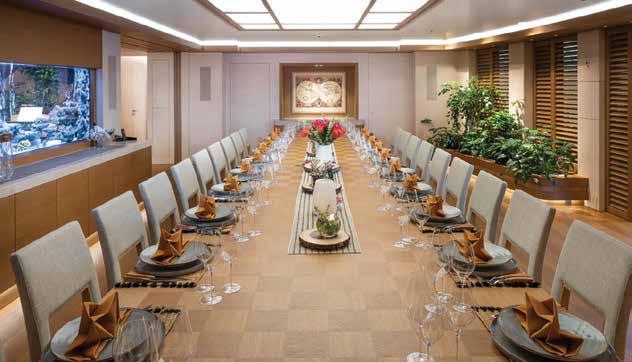

In a striking turn of events, a Jean-Michel Basquiat artwork recently sold for $22 million at an art auction tied to the infamous 1MDB financial scandal—drawing attention not only to its price tag, but also to the turbulent context of its sale.
While details about the work itself—such as its title, medium, or date—have yet to be publicly disclosed, the headline figure of $22 million instantly elevated the sale into a headline-grabbing moment. It’s rare for pieces tied to financial wrongdoing to reach such high valuation in the art market. Held at an auction linked to assets seized in connection to the 1MDB fraud case, the sale gained an unusual spotlight, blending the worlds of high art and high finance in a way that few auctions do.
• Basquiat’s Enduring Magnetism
Even amid scandal-related proceedings, Basquiat’s stature in the art world proves resilient. Despite underlying turmoil, the artwork fetched a market-competitive sum—a reminder of the artist’s unyielding appeal and financial clout.
• Art as Collateral—or Currency
The sale serves as a vivid example of how high-value art can be mobilized within legal and financial frameworks. Art assets are increasingly used, seized, or liquidated in court-related contexts, transforming them from creative expressions into forms of financial leverage.
• Ethical Complexity in Auctions
Auctions like this one prompt questions about the ethics of profiting from artwork linked to fraud. Yet, in art markets, a compelling artist name like Basquiat can eclipse the circumstances of sale when valuation demands are steep.
• New Price Benchmarks in Contested Sales
While not a traditional benchmark-setting auction in a conventional venue like Christie’s or Sotheby’s, the $22 million result nonetheless underscores that even non-mainstream or unusual sales can shift value expectations for certain artists.

• Increased Scrutiny of Provenance
Collectors and institutions may become even more vigilant about an artwork’s legal background—not just its artistic value—before investing or exhibiting, especially when high profile disputes are involved.
• Market Resilience to Contextual Turmoil
The Basquiat sale reinforces that top-tier artists often retain market strength, even when sold under irregular conditions. Brand—and artist legacy—can outweigh situational complexities.
• New Avenues for Asset Liquidation
Institutions handling seized or frozen assets may turn to elevated art sales as a strategic means to recover value, setting precedents for future transactions.
• Ethical Reflections for Collectors
The sale raises sensitive questions—should purchases in these contexts be viewed differently? Are such works “tainted”? The art community may need sharper discussions around ethics when art intersects with scandal.
The $22 million sale of a Basquiat piece, amidst the shadow of the 1MDB scandal, is much more than a high-price headline. It’s a litmus test of the art market’s complex ecosystem— where legacy, legality, and liquidity collide. It demonstrates that Basquiat’s cultural and financial capital remains potent, even when the backdrop is fraught with controversy.
This moment prompts a reevaluation: art is not only a creative medium but also an asset class that can move markets and policies alike— sometimes, in the most unexpected of settings.
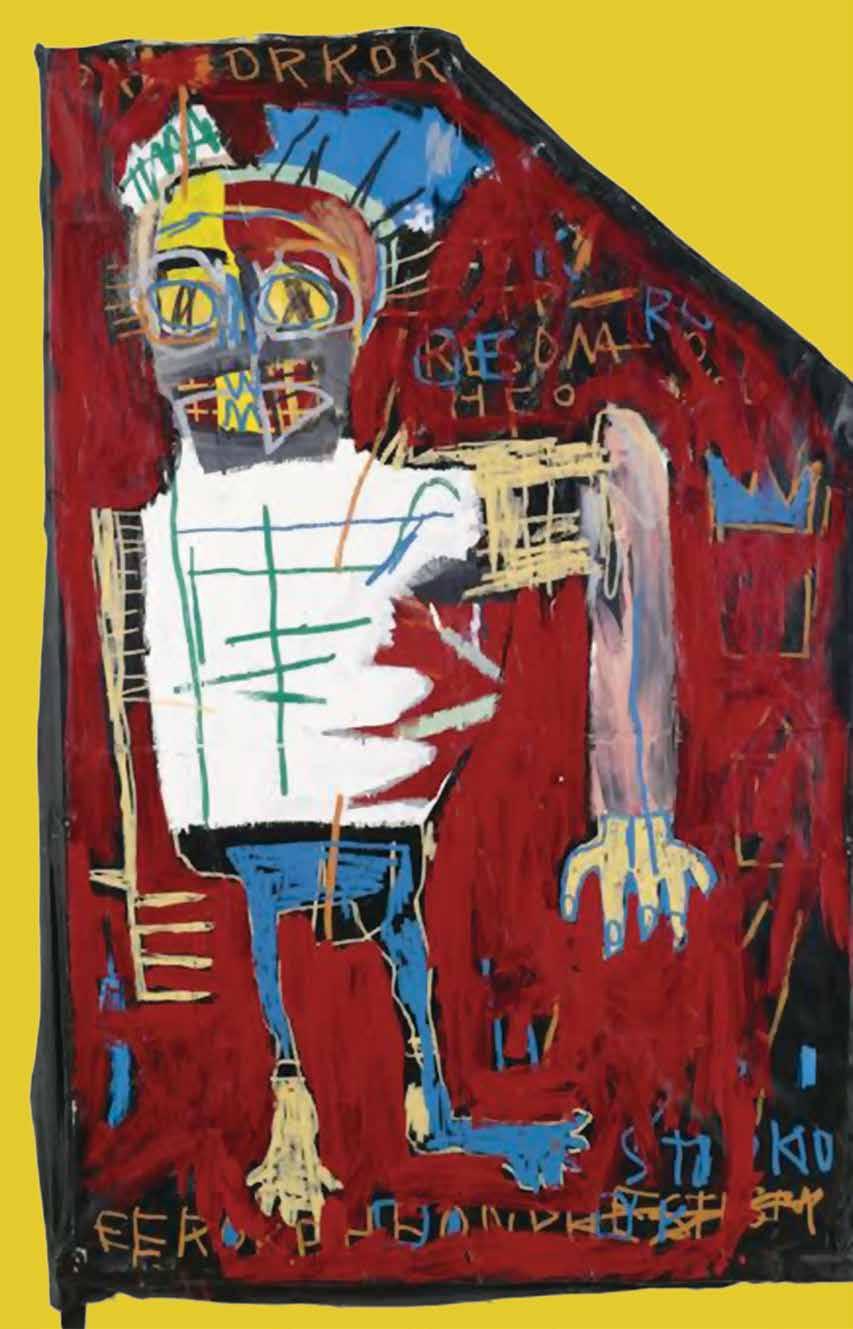



One Battle After Another (Paul Thomas Anderson) — Sep 26, 2025 (wide)
What it is: PTA’s muscular, character-driven action drama tracks a band of former revolutionaries who reunite when an old enemy reemerges, anchoring the story with guilt, loyalty, and the consequences of bygone violence.
Cast heat: Leonardo DiCaprio headlines an ensemble with Sean Penn, Benicio del Toro, Regina Hall, Teyana Taylor, and discovery Chase Infiniti. Why it contends: Anderson’s films traditionally play across Picture/Director/ Screenplay, and early materials hint at editing and sound showcases plus a Greenwood score. The late September Imax supported bow signals confidence.
Avatar: Fire & Ash (James Cameron) — Dec 19, 2025
What it is: The third Pandora chapter pits Jake & Neytiri’s family against the Ash People, expanding the Na’vi moral spectrum while escalating human incursions.
Cast heat: Sam Worthington, Zoë Saldaña, Sigourney Weaver, Kate Winslet, Oona Chaplin, David Thewlis.
Why it contends: VFX, Sound, and Production Design are near-locks on any Cameron sequel; a darker tone keeps Picture/Director chatter alive if the narrative lands.
The Running Man (Edgar Wright) — Nov 14, 2025
What it is: A more faithful take on Stephen King’s dystopia: a hunted man has 30 days to survive a state-sanctioned kill game.
Cast heat: Glen Powell leads, with Josh Brolin, Colman Domingo, Lee Pace, Michael Cera, and more.
Why it contends: Wright’s precision—montage, music, and kinetic geography—could push Editing, Sound, and Production Design into the race; if Powell lands a layered everyman, Acting buzz follows.




The Smashing Machine (Benny Safdie) — Oct 3, 2025
What it is: A bruising biopic of MMA great Mark Kerr that favors addiction, love, and recovery over sports cliché.
Cast heat: Dwayne Johnson (career-best notices) and Emily Blunt. Why it contends: A Venice 15-minute ovation put Johnson squarely in Best Actor conversations; if A24 sustains momentum, Picture and Supporting Actress (Blunt) are plausible.
Marty Supreme (Josh Safdie) — Dec 25, 2025
What it is: A Safdie-grade odyssey about an ambition-addled dreamer crashing through American myth and media.
Cast heat: Timothée Chalamet, Gwyneth Paltrow, Odessa A’zion, Kevin O’Leary, Tyler Okonma, Abel Ferrara, Fran Drescher.
Why it contends: Holiday corridor + Safdie chaos + Chalamet’s showman instincts = Actor and Original Screenplay potential if it sticks the landing.
Hamnet (Chloé Zhao) — Nov 27 limited; Dec 12 nationwide (Focus)
What it is: An intimate, devastating portrait of Agnes (Jessie Buckley) and William Shakespeare (Paul Mescal) wrestling with grief for their son—how loss becomes art.
Cast heat: Buckley and Mescal draw raves; Emily Watson and Joe Alwyn support.
Why it contends: Glowing Telluride reception and first trailer buzz position it as an acting showcase (Buckley, Mescal) with path-to-Picture legs if the rollout holds.
Jay Kelly (Noah Baumbach) — Nov 14 select; Dec 5 Netflix
What it is: A mid life odyssey for a movie star and his long suffering manager—fame, friendship, and the self-myth we sell.
Cast heat: George Clooney, Adam Sandler, Laura Dern, Billy Crudup, Riley Keough; score by Nicholas Britell.
Why it contends: Venice brought an 8–9 minute ovation and split critics— some ecstatic on Clooney/Sandler, others dismissive—making Supporting Actor (Sandler) the clearest lane, with Picture still viable if reviews climb in the U.S. press.


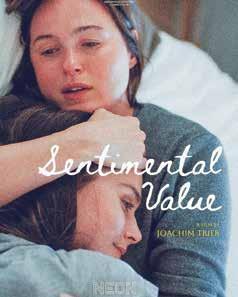

The Testament of Ann Lee (Mona Fastvold) — festival 2025; release TBA
What it is: A daring historical musical about Shaker founder Ann Lee—ecstasy, persecution, and radical faith.
Cast heat: Amanda Seyfried (singing), with Thomasin McKenzie and Lewis Pullman.
Why it contends: Venice’s 15-minute ovation and Seyfried’s transformation ignite Best Actress talk; a specialized rollout could convert cine-curiosity into Academy votes across Costumes, Production Design, and Sound.
Frankenstein (Guillermo del Toro) — Oct 17 theaters; Nov 7 Netflix
What it is: A gothic, empathic reimagining foregrounding the Creature’s pathos and the hubris of his maker.
Cast heat: Oscar Isaac (Victor), Jacob Elordi (the Creature), Mia Goth, Christoph Waltz.
Why it contends: Venice response (13-minute ovation) plus del Toro’s craft pedigree point to Makeup & Hairstyling, Production Design, Score (Desplat), and Supporting Actor (Elordi) possibilities—Picture if the narrative moves voters.
Sentimental Value (Joachim Trier) — Cannes premiere; rolling fall dates
What it is: A meta family saga about an egotist filmmaker (Stellan Skarsgård) and estranged daughters (Renate Reinsve et al.), folding memory into moviemaking.
Cast heat: Reinsve, Skarsgård—notes of Worst Person chemistry with a wiser, thornier edge.
Why it contends: Smart, unflashy craft with acting fireworks; International Feature (if eligible) and Screenplay look strong, with acting lanes open depending on distributors’ priorities.
Bugonia (Yorgos Lanthimos) — Oct 31, 2025 (Focus)
What it is: A grief-warped true-believer (Jesse Plemons) kidnaps a titan (Emma Stone) he suspects is an alien—satire meets abduction thriller.
Cast heat: Stone and Plemons reunite with Lanthimos; Alicia Silverstone supports.
Why it contends: Venice/Telluride chatter lauds Plemons’ intensity; Lanthimos’ recent Academy streak keeps Picture/Acting/Screenplay live, though the tone’s deliberate weirdness can polarize voters.




No Other Choice (Park Chan-wook) — Korea Sep 24, 2025; festivals ongoing
What it is: A black comic corporate thriller (from Westlake’s The Ax): layoff despair curdles into violence and moral acrobatics.
Cast heat: Lee Byung-hun, Son Ye-jin, Park Hee-soon.
Why it contends: Venice ovation and early rave pull-quotes suggest Director/Screenplay traction and a potent International Feature bid if Korea submits it.
Nouvelle Vague (Richard Linklater) — Oct 31 limited (U.S.); Nov 14 Netflix
What it is: Linklater’s black-and-white, French-language love letter to the shoot of Godard’s Breathless—cinephile catnip.
Cast heat: Guillaume Marbeck (Godard), Zoey Deutch (Jean Seberg), Aubry Dullin (Belmondo).
Why it contends: Directors love movies about moviemaking; Cinematography, Editing, and Screenplay are in play, with Picture possible if Netflix marshals a focused campaign.
A Big Bold Beautiful Journey (Kogonada) — Sep 19, 2025 (Sony)
What it is: A romantic fantasy about strangers connected by magical “doorways” through memory and time—Kogonada’s minimalist lyricism meets Joe Hisaishi’s score.
Cast heat: Margot Robbie & Colin Farrell, with Phoebe Waller-Bridge and Kevin Kline.
Why it contends: If audiences embrace its sincerity, this is a stealth Picture/ Score/Original Screenplay play; strong craft lanes in Production Design and Editing, too.
HIM (Justin Tipping/Jordan Peele’s Monkeypaw) — Sep 19, 2025 (Universal)
What it is: A sports-horror chamber piece: a phenom QB (Tyriq Withers) falls under the thrall of a legend (Marlon Wayans) at an isolated compound; fame, body, and mind in jeopardy.
Cast heat: Wayans’ eerie gravitas is the hook; Julia Fox raises the temperature.
Why it contends: Genre bias is real, but Get Out proved the Academy can bite—Sound, Editing, Score (Bobby Krlic) and a potential Supporting Actor swing for Wayans.

Wake Up Dead Man: A Knives Out Mystery (Rian Johnson) — Nov theatrical (limited); Dec 12, 2025 Netflix What it is: Benoit Blanc tackles a darker, Gothic-tinted whodunit.
Cast heat: Daniel Craig with a murderers’ row (Josh O’Connor, Glenn Close, Josh Brolin, Mila Kunis, Jeremy Renner, Kerry Washington, Andrew Scott, Cailee Spaeny).
Why it contends: Screenplay is always live in this franchise; if the mood shift pays off, Production Design and Score can join. TIFF world premiere timing keeps it buzzy.

• Acting showcases: Hamnet (Buckley/Mescal), Jay Kelly (Sandler/ Clooney), Smashing Machine (Johnson), Frankenstein (Elordi/Isaac) have the clearest performance narratives right now.
• Auteur heavyweights: Anderson, Park, Linklater, Lanthimos, del Toro, Zhao—all command top-tier guild respect, fueling Director/Screenplay lanes against Sinners.
• Tech titans: Avatar: Fire & Ash is the category bully below-the-line; Running Man and HIM could be craft spoilers if they over-deliver.
• Release chessboard: September world premieres (Hamnet, Nouvelle Vague, A Big Bold Beautiful Journey, HIM) begin the narrative; late-year arrivals (Avatar, Marty Supreme, Wake Up Dead Man) close it. Strategy matters as much as raves.
If Sinners is as strong as buzz implies, it’s facing a field with clear lanes: intimate grief (Hamnet), maximal craft (Avatar), “actor transforms” stories (Smashing Machine, Frankenstein), and auteur statements (One Battle After Another, Bugonia, No Other Choice). The next checkpoints—TIFF, NYFF, and first guild screenings—will clarify which of these stick the landing.
calendar (U.S. unless noted)
• A Big Bold Beautiful Journey
SEP 19 (Sony, theatrical)
• HIM — SEP 19 (Universal, theatrical)
• One Battle After Another — SEP 26 (wide)
• No Other Choice — SEP 24 (Korea theatrical after Venice/Busan)
• Frankenstein OCT 17 (theaters), NOV 7 (Netflix)
• Nouvelle Vague OCT 31 (select U.S.), NOV 14 (Netflix)
• Bugonia — OCT 31 (Focus, U.S.)
• The Running Man — NOV 14 (Paramount)
• Jay Kelly — NOV 14 (select), DEC 5 (Netflix)
• Hamnet — NOV 27 limited; DEC 12 wide (Focus)
• Marty Supreme — DEC 25 (A24)
• Wake Up Dead Man: A Knives Out Mystery NOV (select), DEC 12 Netflix
• Avatar: Fire & Ash DEC 19 (20th Century Studios)


“Star
50 Years of a
In 2027, the world will commemorate a milestone that once seemed as distant as Tatooine itself: the 50th anniversary of Star Wars: A New Hope. This epochal celebration isn’t just a nod to history—it’s a thrilling reminder of a film that redefined science fiction cinema and embedded itself in the fabric of popular culture.
Lucasfilm has announced a limited theatrical re-release of A New Hope beginning April 30, 2027, running through May the 4th, the beloved Star Wars Day. Fans worldwide will have the chance to experience Luke Skywalker’s inaugural adventure as it once was meant to be seen—on the big screen.
One burning question remains: Which version of the film will be shown? Over the years, George Lucas introduced several alternate cuts—including the controversial Special Editions—which have divided purists and casual fans alike. As of now, Lucasfilm hasn’t confirmed whether the theatrical or a restored version will be featured during the anniversary run.
This re-release marks just the beginning of a yearlong celebration, honoring half a century since George Lucas first transported audiences into that galaxy far, far away. Expect events, retrospectives, and perhaps surprises that will rekindle the Force in fans new and old.
Since its 1977 debut, A New Hope has transcended film genres to become a cultural landmark. It not only launched a multimedia entertainment empire but also shaped generations of storytelling, special effects, and myth making in cinema. Its groundbreaking use of practical effects and its iconic “used future” aesthetic have influenced countless productions. John Williams’s Academy Award–winning score remains an indelible part of the film’s identity.
As anticipation builds for the 50th anniversary, fans may also get a glimpse of what’s next in this ever-expanding universe. Just announced: a newly greenlit feature film titled Star Wars: Starfighter, slated for release May 28, 2027, directed by Shawn Levy and starring Ryan Gosling. This marks a bold step beyond the Skywalker saga into uncharted territory.
Half a century after its premiere, Star Wars: A New Hope continues to inspire, as mesmerizing now as it was in 1977. Whether you’re a lifelong devotee or a newcomer drawn by the pull of its legend, the upcoming anniversary offers something truly special: a shared journey back to where it all began—with hope, rebellion, and destiny.
— May the 4th—and the Force—be with you.
Remembering the man who redefined modern luxury
Few designers have shaped the global fashion landscape as profoundly as Giorgio Armani. Born on July 11, 1934, in Piacenza, Italy, Armani’s journey from a modest upbringing to becoming a fashion icon is the stuff of legend. In 1975, he launched his eponymous label with a vision that challenged the excesses of the era. While others leaned into opulence, Armani embraced clean lines, neutral palettes, and impeccable tailoring — creating a new language of elegance.
“Elegance is not about being noticed. It’s about being remembered.”
—Giorgio Armani
Armani became synonymous with the power suit, redefining how success looked in the late 20th century. His softly tailored blazers and fluid silhouettes gave men and women alike a quiet authority that resonated globally. Hollywood embraced him wholeheartedly. When Richard
Gere donned Armani in American Gigolo (1980), a cultural shift began. Soon, Armani became the designer of choice for A-list stars and red carpets, from Michelle Pfeiffer to George Clooney. His influence transcended fashion — it became a movement of confidence and sophistication.
Armani’s brilliance extended far beyond the runway. He cultivated a lifestyle empire that touched nearly every facet of luxury:
Armani Privé — Haute couture collections that dominate Paris Fashion Week
Emporio Armani & Armani Exchange — Making luxury more accessible
Armani Hotels & Resorts — Where design meets hospitality Armani/Casa — Bringing refined minimalism into the home Through it all, Armani championed Italian craftsmanship, marrying tradition and innovation while staying true to his aesthetic philosophy.
As we mourn Giorgio Armani’s passing, we reflect on a life defined by restraint, refinement, and vision. His creations were never about extravagance — they were about confidence without noise.
From boardrooms to boulevards, Armani’s influence is everlasting.
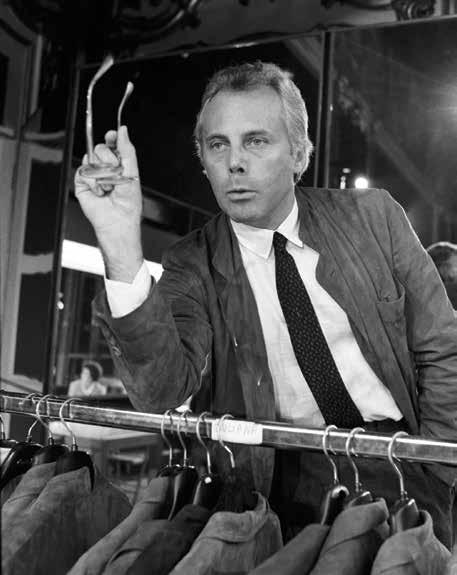
He didn’t just clothe people; he empowered them to express strength through simplicity. Xposure Magazine extends our deepest condolences to Giorgio Armani’s family, friends, colleagues, and countless admirers around the globe. His passing marks the end of an era, but his vision will continue to shape the world of fashion for generations to come.
Armani once said, “Style is the only real luxury that is truly timeless.” In honoring his memory, we celebrate not just his work, but the elegance and humanity he infused into everything he touched.
Giorgio Armani’s name will forever stand as a beacon of sophistication, innovation, and enduring elegance. In an industry defined by fleeting trends, he created a timeless standard. His legacy lives on — stitched into the fabric of culture itself.



“I design for real people, for the lives they live today”
—Giorgio Armani

When Anna Wintour first slipped on those oversized sunglasses decades ago, she likely had no clue she’d become the face of modern fashion media. But after nearly 37 years at Vogue’s helm, she has quietly passed much of that crown — not to a rebellious interloper or outsider shock candidate, but to a familiar insider: Chloe Malle, now Vogue’s new Head of Editorial Content.
Enter the Malle Era (with a Wintour safety net) Malle, 39, is no rookie. A longtime Vogue veteran who has written for The New York Times, The Wall Street Journal, and others, she most recently led Vogue.com and co-hosted the magazine’s podcast, The Run-Through. Her appointment signals more than a stylistic shift — it’s a structural realignment. Gone is the title “Editor in Chief” in the American division; in its place, “Head of Editorial Content”— a role that reports to Wintour in her new, loftier positions as global editorial director of Vogue and Condé Nast’s chief content officer.
In other words: Wintour isn’t retiring; she’s moving back into the VIP box. She will continue to steer global brand strategy, oversee major Vogue events (like the Met Gala), and mentor the new guard. Malle will handle the
daily grind — from cover stories and department critiques to digital expansion and cross-platform storytelling. It’s Vogue’s answer to generational handoffs in the era of clicks, reels, and global reach.
Wintour isn’t retiring; she’s moving back into the VIP box.
First: this relinquishing of day-today authority is a tacit acknowledgment that fashion media no longer runs on print alone. Expertise in digital content, multimedia, and audience engagement now outweigh pure editorial eagle eyes. Malle’s resume suggests she can straddle those demands.
Second: the shift allows Wintour to cast her gaze wider. As Condé Nast’s chief content officer, she’ll influence not just Vogue but the creative direction of titles like GQ, Vanity Fair, and Wired. The brand she built won’t vanish — it will evolve under her supervision. Think of Malle as CEO of Vogue U.S., and Wintour as chairperson of the entire Vogue universe.
Third: The optics matter. In a moment when fashion — and media more broadly — is under scrutiny for representation, tone,
and inclusivity, having a new face with a reputation for editorial curiosity sends a symbolic message. Whether Malle becomes a transformative or transitional figure remains to be seen.
Finally: the title change itself isn’t trivial. Replacing “Editor in Chief” with “Head of Editorial Content” suggests Vogue is embracing a flatter, more integrated model — one where content (in all its glorious forms) comes first. The old editorial hegemony may be giving way to a more agile, collaborative era.
Vogue has long operated as fashion’s crown jewel — a cultural arbiter whose influence ripples far beyond glossy spreads. Wintour’s reign made Vogue into a global institution; her choice of successor will help determine whether it remains relevant in a fractured, fast-scrolling era. If Malle nails this era of hybrid storytelling — balancing print integrity with digital ferocity — Vogue might survive its biggest test yet: staying indispensable when everything else competes for our half-attention. And if she missteps, it could be the crack in the façade that finally lets the house of gloss crumble.
So, raise a glass — or at least a pamphlet — to the new guard. The baton has been passed, but the eyes of fashion’s citizens are firmly fixed.
Malcolm-Jamal Warner’s life is a study in evolving artistry—and enduring influence. Best known to many as Theo Huxtable on The Cosby Show, his journey casts a wide arc: child actor, award-winning performer, director, poet, musician, mentor—and, in his untimely passing in 2025, a legacy that continues to inspire.

Born in Jersey City, New Jersey on August 18, 1970, Warner was named in homage to Malcolm X and jazz legend Ahmad Jamal. When he was five, his family relocated to Los Angeles, where he showed early interest in performing. He later attended The Professional Children’s School in New York City, balancing academic training with his early work in entertainment. In 1984, at age 14, Warner won the role that would define a generation: Theodore “Theo” Huxtable, the only son in the Huxtable family, on The Cosby Show. His performance earned him an Emmy nomination for Outstanding Supporting Actor in a Comedy Series in 1986.
While The Cosby Show anchored his public identity, Warner was always pushing into new terrain. During his early years on the show, he began directing—handling music videos and eventually directing episodes of prominent sitcoms, including The Fresh Prince of Bel-Air, Kenan & Kel, and others. He also cultivated his voice as a musician and poet. In 2003 he released The Miles Long Mixtape, and later albums followed. In 2015, Warner won a Grammy Award for Best Traditional R&B Performance for “Jesus Children,” a collaboration with Robert Glasper Experiment and Lalah Hathaway. In 2022, he produced a spoken-word album, Hiding in Plain View, earning a Grammy nomination in the new spoken-word poetry category. On television, Warner built a versatile résumé. After The Cosby Show ended in 1992, he starred in Malcolm & Eddie (1996–2000), Reed Between the Lines (2011, 2015), and recurring roles in Suits and The Resident. In 2024, he embraced podcasting with Not All Hood, exploring Black culture and community through candid conversations.
Though he lived in the public eye, Warner kept much of his personal life private. He shared meaningful relationships with fellow actors, most notably Michelle Thomas and Regina King, before marrying
Tenisha Warner in 2017. Together, they welcomed a daughter. Friends and colleagues consistently described him as thoughtful, generous, and grounded— qualities that shaped his artistry and his life beyond the screen.

On July 20, 2025, Warner died tragically by drowning while on a family vacation in Costa Rica. He was 54 years old. Despite heroic efforts from surfers and lifeguards, he was pronounced dead after prolonged resuscitation attempts. The cause was confirmed as accidental drowning. His passing reverberated across entertainment and cultural communities, sparking tributes that celebrated not only his iconic role as Theo but also his decades of creative contributions. His widow, Tenisha, later announced two initiatives in his name: the Warner Family Foundation, offering scholarships to young artists, and River & Ember, a program dedicated to family bonds and creative nurture. Warner once reflected that while The Cosby Show granted him “immortality,” he hoped to be remembered for the breadth of his life and art: “because I’ve had this full life after that show, there’s another lane of legacy that I get to leave.”
Indeed, Malcolm-Jamal Warner leaves behind not just a beloved character, but a multifaceted legacy—artist, mentor, and cultural voice—that continues to resonate.


Robert Redford’s life read like a grand narrative of American cinema: from promising young actor to respected director, visionary institution-builder, and committed environmentalist. He died on September 16, 2025, at his home in Sundance, Utah, at the age of 89.
Born Charles Robert Redford Jr. on August 18, 1936, in Santa Monica, California, Redford grew up in a modest household. Though he briefly attended the University of Colorado on a baseball scholarship, he dropped out and drifted, immersing himself instead in art and theater. Redford’s early career included Broadway roles (such as in Barefoot in the Park) and TV guest
appearances in series like Route 66 and Alfred Hitchcock Presents. His breakout came in film, especially with Butch Cassidy and the Sundance Kid (1969), in which he co-starred with Paul Newman. That role cemented his status as a leading man in Hollywood’s new wave era.
Throughout the 1970s and 1980s, Redford starred in a string of classics: The Way We Were, The Sting, All the President’s Men, Out of Africa, and others. Each role amplified his blend of charisma, emotional nuance, and an underlying moral seriousness.

Redford’s ambitions extended beyond acting. His directorial debut came in 1980 with Ordinary People, a film that won him the Academy Award for Best Director and also garnered Best Picture. He later directed films like The Horse Whisperer and Quiz Show, showcasing his sensitivity and narrative intelligence.
But perhaps Redford’s most lasting impact lies in his founding of the Sundance Institute and the Sundance Film Festival. Beginning in the late 1970s, these efforts became a cornerstone of independent filmmaking in the U.S., providing platforms, mentorship, and visibility to countless emerging voices. Through these institutions, Redford transformed a local Utah ski area and mountain community into a cultural magnet bearing his former screen alias, “Sundance.” He also operated a production company, Wildwood Enterprises, supporting projects aligned with his artistic and ethical values.
Redford was never content to separate art from principle. He was a vocal environmentalist, a trustee of the Natural Resources Defense Council, and an advocate for Native American rights and liberal causes. His commitment to land, nature, and sustainability

informed not only his activism but also his lifestyle in Utah. Redford’s personal life included a long marriage to Lola Van Wagenen (1958–mid-1980s) during which they had four children (one died in infancy). Later, he married Sibylle Szaggars in 2009. Despite fame, he mostly kept a private persona, preferring his work and causes to speak for him.
Robert Redford passed away peacefully at his home in Sundance, Utah. His death triggered an outpouring of tributes across the film world, honoring him not just as a star but as a mentor, institution-builder, and moral force.
He leaves behind a legacy that is multifaceted: unforgettable performances, distinctive directorial works, and a thriving ecosystem for independent film. Through Sundance, Redford empowered voices that may otherwise have gone unheard. His environmental advocacy and principled engagement remind us that an artist’s responsibility can extend beyond the screen. The arc of his life underscores that true influence often lies in building institutions, opening doors, and amplifying others.
Robert Redford will be remembered as much for his roles on camera as for the vision he nurtured off it—an enduring figure in American culture whose impact will continue to ripple for generations.